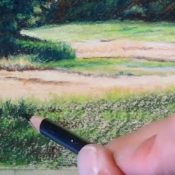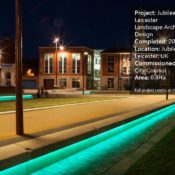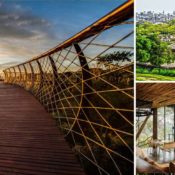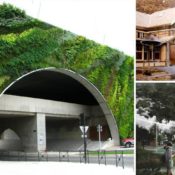Author: Land8: Landscape Architects Network
3 Projects Show how Green Infrastructure can Solve our Global Problems
Article by Alexis Alvey – In this article, we explore how three projects show how green infrastructure can solve our global problems. Traditionally, the management of stormwater has relied upon the use of underground pipes, pumps, and other devices used to control the direction and flow of water. However, these gray infrastructure systems require a large capital investment, costly maintenance, and can fail. Green infrastructure, on the other hand, offers a low-cost, adaptable solution that encompasses innovative design strategies used to manage stormwater and flooding while minimizing the impact of development. Strategies are diverse, and can range from permeable paving systems to green roofs to strategically planted street trees.
Green Infrastructure
Below are three exemplary projects from three major cities across the United States that demonstrate how green infrastructure can be successfully incorporated into the parks, streets, and plazas where we live, work, and play.
Buffalo Bayou Promenade
In Houston, Texas, the Buffalo Bayou Promenade, designed by SWA Group, is a 1.2-mile stretch of riverfront that links the city center with an urban park. Although the bayous and rivers of Houston have been essential to the city’s development since its birth in 1836, the city continues to be plagued by major flooding events.
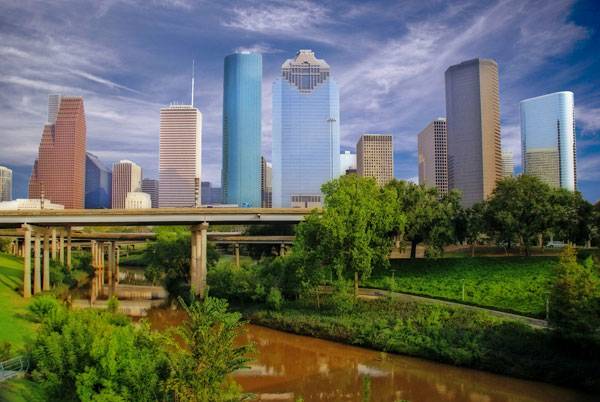
Downtown Houston, the I45 freeway and the Buffalo Bayou, taken from Sabine Street. By source.
300,000 Plants were Planted
Flood control was therefore one of the necessary goals of the project and green infrastructure was employed to combat this. Existing steep slopes were regraded and stabilized with stone-filled gabions to control bank erosion, and riverbanks were vegetated to provide maximum flood control. A total of nearly 300,000 plants were planted, with a focus on flood-adapted and native species. Swales made of recycled concrete were also installed to help absorb high volume water flows. By utilizing green infrastructure, Houston residents now have 23 additional acres of urban greenspace. Improved wildlife habitat is also an important benefit of green infrastructure, and ducks, herons, turtles, and fish have now been spotted along the bayou.
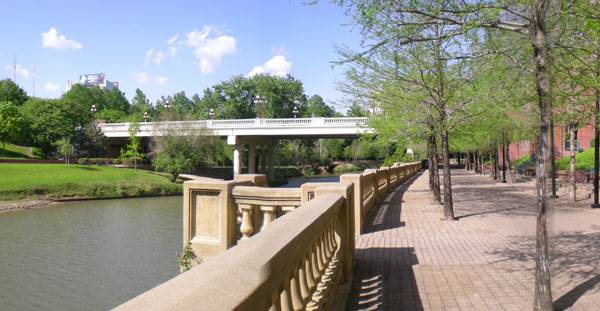
Buffalo Bayou traversing Sesquicentennial Park. By Brian Reading – Own work, CC BY-SA 3.0, Source
The SW 12th Avenue Green Street
The second project is located within the Pacific Northwest climactic zone in Oregon. The city of Portland is faced with a very high annual rainfall rate, and subsequent stormwater management challenges. To combat this, the city has developed a Green Streets initiative. The SW 12th Avenue Green Street project effectively demonstrates how green infrastructure can be retro-fitted into our existing streets. Designed by the city’s Sustainable Stormwater Management Program, SW 12th Avenue now boasts a series of stormwater planters that capture and cleanse street runoff. Before the project was implemented, stormwater had been siphoned into a system that fed directly into the Willamette River.
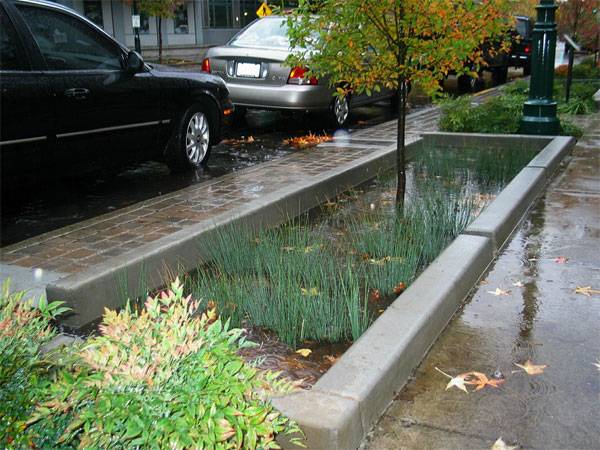
The SW 12th Avenue Green Street © City of Portland, courtesy Bureau of Environmental Services
Reduce the Runoff Intensity by at Least 70 Percent
Now, strategically placed curb cuts and small groves of native rush and Black Tupelo trees allow street runoff to enter planters, be cleansed, and infiltrate soil or head downhill to the next planter. Pedestrian circulation and on-street parking are still maintained in the design, which is now estimated to reduce the runoff intensity of a 25-year storm event by at least 70 percent.
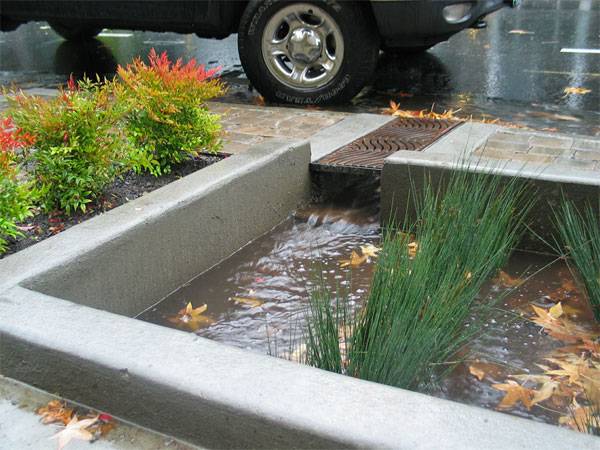
The SW 12th Avenue Green Street © City of Portland, courtesy Bureau of Environmental Services
The Avenue
The last project is from Washington DC, which has also started a Green Streets initiative. The United States capitol is situated in the delta of the Potomac River, the Anacostia River, and the Rock Creek Watershed. Green infrastructure projects are designed to intercept stormwater before it reaches any of these waterbodies.
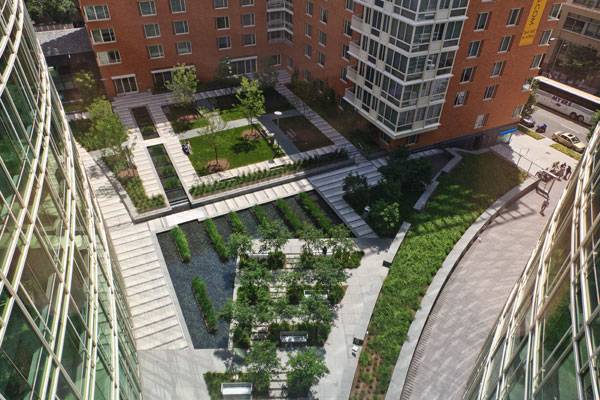
The Avenue ©Craig Kuhner
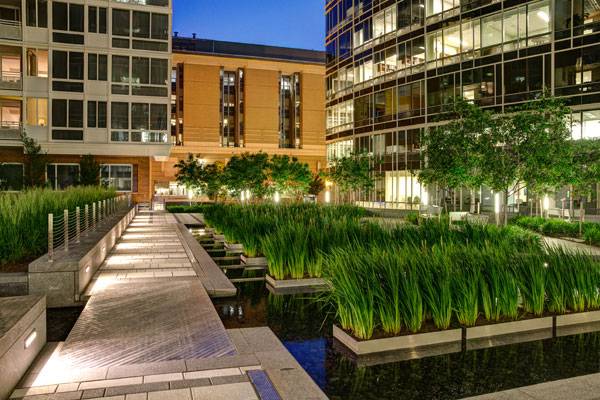
The Avenue ©Craig Kuhner
An 8,000 Square Foot Green Roof
The project also contains 8,000 square feet of green roof, which filters water before it is collected by the cistern. The performance of this project has been assessed, and it is estimated to prevent 76,000 gallons of annual stormwater runoff from entering Washington DC’s aging combined sewer system.
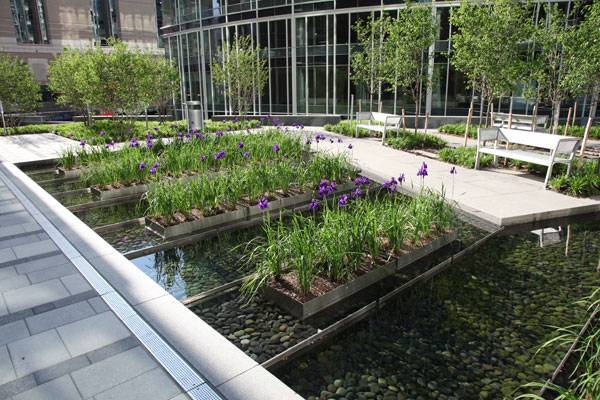
The Avenue ©Craig Kuhner
Recommended Reading:
- Becoming an Urban Planner: A Guide to Careers in Planning and Urban Design by Michael Bayer
- Sustainable Urbanism: Urban Design With Nature by Douglas Farrs
Article by Alexis Alvey
Tips and Tricks for Drawing Better – The 5 Best YouTube Videos
Article by Amela Djurakovac We explore 5 YouTube videos that highlight tips and tricks for drawing better so that you can enhance your ability to get your ideas across. When it comes to drawing, it is a form of art where the learning of new techniques never ends.The fact is that there are so many different ways by which you can improve your existing talent! Beginners, and those who are already engaged in drawing, alike, are constantly looking for new tips and tricks like experimentation with making marks, lines, shapes, tones, textures, proportions and shadows, which will help their drawings be little masterpieces. To express feelings, thoughts or creativity, all you need is a few good-quality exercises that can increase your drawing skills. Some of them are very simple but they can be very useful. We can find them online as tutorials and videos and when you learn the basics of each technique, the rest is only limited by your imagination! Here are some simple but useful bits of advice and YouTube tutorials that will make you want to draw even more.
Tips and Tricks for Drawing
1. “Vision on Paper” –Where to Begin?
All ideas and inspirations come from our minds and all the things that we see, so the first thing before drawing is to ask yourself; what do you want to draw? What feelings and expressions do you want to show? Always start with sketches or diagrammatic drawings and let the paper be the means for transmitting your thoughts. You can also use drawing to research a given task or subject that you want to draw, or use them to try to understand the drawings of other artists. Find your perfect place for drawing, and obtain all the necessary equipment you want to draw with. For an example of where to start, take a look at this video about some art supplies for realistic drawings. WATCH >>> My Essential Art Supplies for Realistic Drawings – FAQ Part 2
2. Use of the Value Scale
The value scale is a very important element of every drawing. Why? Well, drawing is an illusion of shadows and lights and the combination of these factors can really add a professional look to your drawing. You can make your one value scale with different values and create a nice depth for your drawn objects. Pay careful attention to reflected light, shadows, and highlights, so if you want to draw a very realistic picture or abstract subjects or even give a three-dimensional shape the illusion of form, you will need to measure light levels and observe the highlight, mid-tone, core shadow, reflected light, and cast shadow. In perspective drawing, by reducing the contrast in more distant objects, you can effectively portray depth. WATCH >>> The Basics of Highlights Midtones and Shadows
3. The Problem of Dimensions
In everything that we want to draw, there is a problem of dimensions. Finding the right dimensions is really an important step especially when we want to produce a complicated drawing like a human figure. For example, if you want to draw a human face, these are the dimensions that you should know; the eyes are halfway between the top of the head and the chin, the center of the upper lip is halfway between the eyes and the chin, the width of the mouth is the same as the distance between the pupils, and a horizontal line drawn through the center of the eyes should be parallel to a line drawn through the center of the mouth. If you are not sure, you can use the grid method. WATCH >>> Draw Realistically with the Grid, Realism WATCH >>> How to use the Grid Method with a Drawing of Chuck Close as an Example
4. A Combination of Different Drawing Techniques
Sometimes you may be wondering what technique to use for your drawing? And whether, for a particular type of drawing, there is a ‘best’ technique? As you may know, the pencil is one of the most popular drawing tools, and you can use it for all types of drawings, as well as colored pencils. For landscape drawings or adding details, it is good to use watercolors or pastel, although oil pastels are a very expressive media used for impressionistic landscapes. Soft media, such as charcoal, is excellent for atmospheric techniques or quick drawings. This potential you can see in the landscape drawings of Leonardo da Vinci, where he produces atmosphere with a simple piece of chalk. Or, you can use different techniques in combination with hand drawings or digital drawings. For landscape drawings or adding details, it is good to use watercolors or pastel, although oil pastels are a very expressive media used for impressionistic landscapes. Soft media, such as charcoal, is excellent for atmospheric techniques or quick drawings. This potential you can see in the landscape drawings of Leonardo da Vinci, where he produces atmosphere with a simple piece of chalk. Or, you can use different techniques in combination with hand drawings or digital drawings. WATCH >>> Pastel Tips for Drawing and Painting
WATCH >>> Colored Pencil Tips
5. Some Simple key Advice:
- Never save money by buying low-quality drawing accessories
- A smooth, glossy paper requires a much softer pencil, whereas rough paper takes a harder pencil
- The drawing instrument should be connected to your arms – learn how to use it
- Before beginning a drawing, always note where the light is coming from
- If you are not sure whether the composition of your drawing is good, you can make a frame in the shape of a square for different views and pick the best one. Usually landscape drawings are placed on horizontal paper
- Drawing is both a way of seeing and a way of knowing a subject, so look carefully at what you want to draw
- Regardless of technique, color is always added gradually with as little pressure as possible
- To avoid contaminating lighter colored areas with darker ones, paint them first when they are adjacent to darker colors.
- Always keep your hands clean while drawing
- Practice, practice, practice!
Before learning any technique or tips for drawing, you need to enjoy the moments of drawing because it is not just a drawing technique or skill that determine the quality of your drawing, but the love that you express while you are drawing. In the arts, there are no limits, so in addition to daily exercise and experimentation, you need to know yourself through drawing so that it becomes a facet of your lifestyle. In other words, it becomes your response to how you see the world around you. Have you got any tips and tricks for drawing? Let us know in the comments section below!
Recommended Reading:
- SketchUp for Site Design: A Guide to Modeling Site Plans, Terrain, and Architecture by Daniel Tal
- Rendering in SketchUp: From Modeling to Presentation for Architecture, Landscape Architecture and Interior Design by Daniel Tal
Article by Amela Djurakovac Feature Image: Printscreen from featured YouTube Tutorial | Source
How to Build Raised Garden Beds on Your Own
Article by Bilal Sajjad Raised garden beds aka garden boxes are perfect to plant small plots of vegetables or flowers. Before you learn how to build these garden boxes, let me share their advantages:
- They prevent soil compaction.
- They provide good drainage for water.
- They protect the plants from slugs and snails.
- The sides of the boxes keep the soil from eroding when it rains.
- They are easier to tend, freeing you any back strain.
- They Keep the Plants Away From Pathway Weeds
Raised Garden Beds
How to build Raised Garden Beds?
To build raised garden beds, you need some tools and materials. Here’s the list: 1. Lumber 2. Fastenings (Screws, nails, stainless screws) 3. Cross supports (Aluminum flat stock) 4. Hand saw 5. Square 6. Carpenter’s level 7. Mallet or sledge 8. Screwdriver 9. Hack saw 10. Drill WATCH >>> How to Build a Raised Garden Bed with Wood – Easy (EZ) & Cheap
After you gather the above tools and materials, follow the steps given below to start building your own raised garden beds: 1. Cut and build the basic frame: Clear the area where you want to place the garden bed. Decide how long you want it to be and mark the ends of the wooden plank. Cut it with a saw. Use two screws to hold the planks in place. Select the level for the raised garden beds and put blocks underneath it to keep the level.
2. Screw boards into the corner posts:
When cutting the posts, keep them longer than your actual need. Saw a point on the bottom of the posts. Arrange the first post in the corner of the wooden frame. Insert the post a few inches deep into the ground. Use two screws per side to attach the frame to the post. Do the same with the other posts and screw them similarly.
3. Insert the boards to the ground:
To add the bottom row of boards to the ground level, use the same method of screwing into the posts. To fit the boards in place, push them into the ground. Now, cut the posts that are sticking up using a saw. Now that they are flush to both sides of the bed, smoothen the ground in the pathway and fill the raised garden bed with soil.
4. Add cross bracing:
If you want your raised garden beds to be longer than 8 feet and taller than 18 inches, it is wise to use cross bracings. This way you can prevent the garden beds from bowing outwards in the center. Take an aluminum flat stock and cut it to a width equal to that of your garden bed using a hacksaw. Using a drill machine, make holes on each end of the stock and attach the cross brace to either side of the posts with 1 inch stainless screws.
5. Top with soil. Start gardening!!
Collect the best soil from your garden to fill your raised garden beds. Screen the soil through a half inch mesh if it contains rocks and stones. If you don’t have a mesh, you can do so with your hands too, only it will take more effort. Add different soil amendments like lime, organic fertilizers, peat and rock phosphate to improve the fertility of the soil as required. Shower the soil with a fine spray and then top with more soil, because the soil level lowers a bit owing to water. Done!! Your raised garden beds are ready for gardening. Apart from raised garden beds, if you want to beautify your garden yourself, you can check out these amazing garden shed ideas too.
WATCH >>> How to Build a Raised Garden Bed for Under $15!
Recommended Reading:
- Becoming an Urban Planner: A Guide to Careers in Planning and Urban Design by Michael Bayer
- Sustainable Urbanism: Urban Design With Nature by Douglas Farrs
Article by Bilal Sajjad Featured image: © Copyright Steve Daniels and licensed for reuse under this Creative Commons Licence
5 Ways Jubilee Square Leicester Brings Spaces Back Together
Article by Nour Adel Jubilee Square Leicester, by LDA Design, in Jubilee Square, Leicester, UK Every day new, modern, beautiful public parks are being constructed, unfortunately, they don’t always relate to the old historic buildings and cultural assets which give a city its identity and uniqueness. In the early 1970’s, a new inner ring road and the construction of St Nicholas Circle destroyed the medieval urban grain of St Nicholas Place, turning it into a peripheral space, and isolated the river and castle area from the city centre. Jubilee Square in Leicester city is a dynamic new piece of public realm which has succeeded in re-connecting the heart of the city of Leicester to its heritage. Jubilee Square, designed by LDA Architects, has been created on the site of a car park. The aim of the square is to re-connect the heart of the city to several important historic assets.
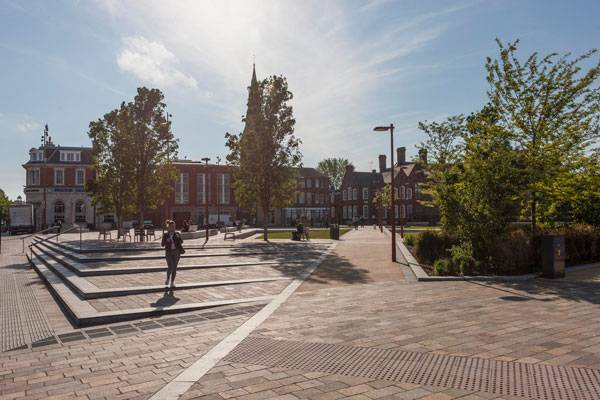
Jubilee Square Leicester by LDA Design. Photo credit: Robin Forster
Jubilee Square Leicester
1. It Provides Easy Pedestrian Access Points
Jubilee Square connects the city together and improves pedestrian accessibility. Key pedestrian desire lines and visual axes were mapped. The route between the Cathedral and St Nicholas Church, a diagonal line across the space, defines a paved area to the north relating to High Street, and a green-lawned area to the south.
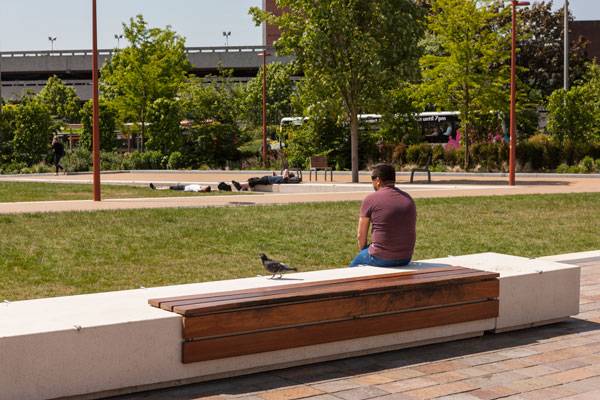
Jubilee Square Leicester by LDA Design. Photo credit: Robin Forster
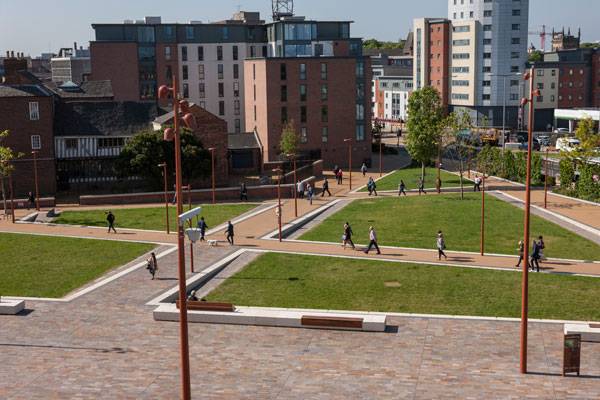
Jubilee Square Leicester by LDA Design. Photo credit: Robin Forster
2. It Brings People Together
“Landscape architecture can’t force people to connect, it can only plan the crossing points, remove barriers, and make the meeting places useful and attractive.” – Denise Scott Brown That being said, although the main target was to link the spaces together, it has also managed to link the individuals together. It has been designed to be a new hub for recreation and relaxation. The scale of the space, the anticipated footfall, and the need for flexibility of use all pointed the design team towards a hybrid hard and soft space, with large lawns and a paved area.
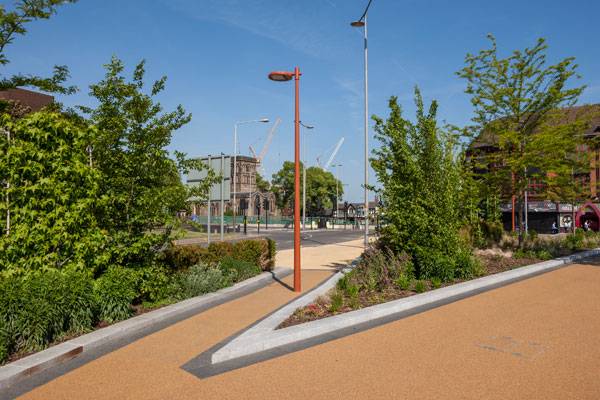
Jubilee Square Leicester by LDA Design. Photo credit: Robin Forster
3. It Makes Functional Use of Levels
Site levels were built up at the highest point to help screen the traffic on St Nicholas Circle and to create a hard paved space edged by a flight of shallow steps, tapering into the natural slope. The levels falling across the lawned area to the southern and western edges add to the sense of dynamism. The northern part of the square is paved in porphyry, with the relocated High Cross pillar as a new focus. Vehicular access to Highcross Street is provided as a shared surface, defined by coordinated street furniture on either side. Three long, south-facing communal bench seats have sunny views over lawned and paved areas. To the south, Wygston’s House, Leicester’s oldest timber-framed building, now belongs to the public realm, with new railings and low planting replacing a wall.
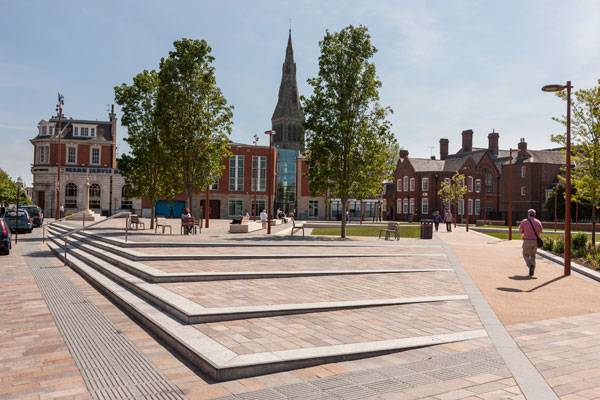
Jubilee Square Leicester by LDA Design. Photo credit: Robin Forster
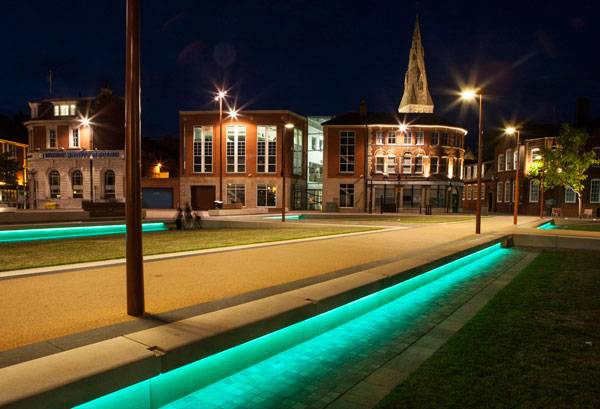
Jubilee Square Leicester by LDA Design. Photo credit: Robin Forster
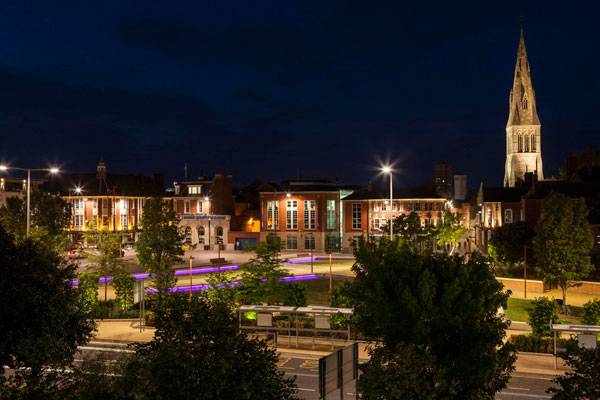
Jubilee Square Leicester by LDA Design. Photo credit: Robin Forster
5. It Features a Wide Variety of Beautiful Plants
When it comes to landscape and planting design, there has been a strong emphasis on horticultural distinction, with large new beds filled with Agapanthis inapertus intermedius, Aster azureus, Carex testacea, three different types of Echinacea, Liatris aspera, Parthenium integrifolim, Ruellia humilis, Themeda triandra and Tritinia disticha. A canopy of mature trees include a large specimen Acer x freemanii ‘Autumn Blaze’ Liquidambar styraciflua, Catalpa bigonoides, Gleditsia triacanthos, Carpinus betulus ‘fastigiata’, and Amelanchier lamarckii . On top of this a historic Arbutus unedo – Strawberry tree – is retained.
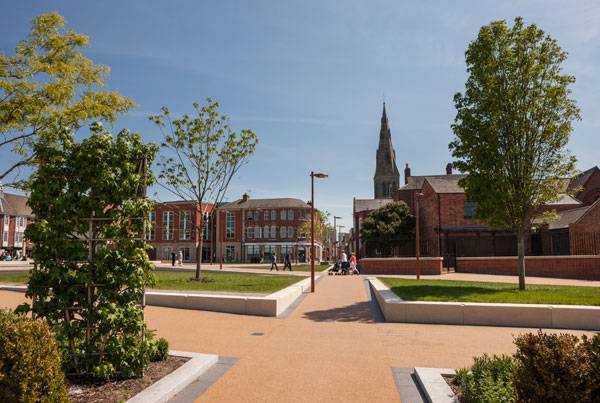
Jubilee Square Leicester by LDA Design. Photo credit: Robin Forster
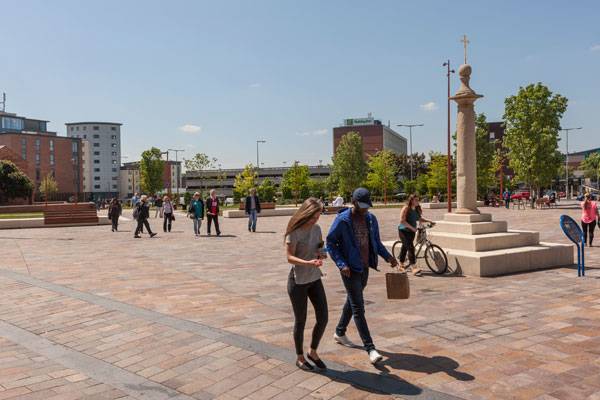
Jubilee Square Leicester by LDA Design. Photo credit: Robin Forster
Full Project Credits For Jubilee Square Leicester :
Project: Jubilee Square Leicester Landscape Architect: LDA Design Design Team Leader: Robert Aspland, Benjamin Walker, Tim South Lighting Designer: Sutton Vane Associates Completed: 2015 Location: Jubilee Square, Leicester, UK Commissioned by: Leicester City Council Area: 0.8Ha Recommended Reading:
- Becoming an Urban Planner: A Guide to Careers in Planning and Urban Design by Michael Bayer
- Sustainable Urbanism: Urban Design With Nature by Douglas Farrs
Article by Nour Adel
8 Amazing Benefits of Trees That will Blow Your Mind
Article by Alexis Alvey We explore the amazing benefits of trees , the benefits of trees that go unnoticed, beneath the surface but yet affect us all. The Beatles once said, “All you need is love.” But they were wrong – all you really need are trees! As we continue to learn more and more about trees – how they grow, the integral role they play in our lives, and their life-sustaining support of the global ecosystem – it becomes increasingly obvious how amazing trees really are. Most people think only about the environmental benefits of trees, but did you know that trees can also make a great positive impact socially and economically? Below are some little-known facts about trees that will transform you into a full-blown tree-lover… if you aren’t one already!
8 Amazing Benefits of Trees
8. Trees Reduce Crime
By providing an inviting place to gather, public green spaces can increase the perception of safety even within tough, inner-city neighborhoods. After analysis of crime patterns in a community in Chicago, Illinois, U.S., it was found that fewer violent and property crimes occurred in natural areas with dense trees and grass. Also, the trees and other vegetation may directly mitigate residents’ irritability, inattentiveness, and impulsive behavior, leading to fewer crimes.
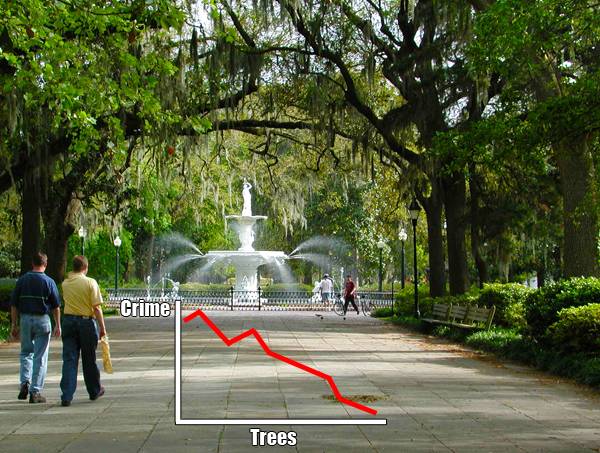
Trees-in-the-landscape – More trees = Less crime. Image: Savannah Park with FountainCC BY-SA 3.0 by Fgrammen
7. Trees Increase Home Values
Don’t underestimate the value of curb appeal when it comes to trees and your home! Various studies from the East Coast of the United States have shown that when strategically located, healthy, well-maintained trees can increase the sale price of a home by 5-10%. Furthermore, homes with “excellent” landscapes can sell for 16-20% more than homes with “poor” landscapes.
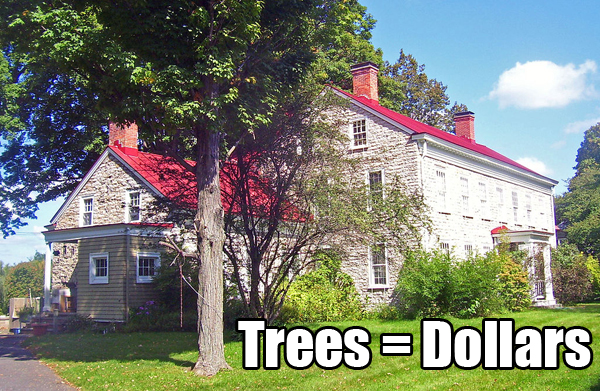
Increase the sale price of your house by planting trees outside it. Image: Jacob Ten Broeck Stone House, Kingston, NYCC BY-SA 3.0, by Daniel Case
6. Trees Foster Community
Street trees and associated vegetation significantly contribute to residents’ feelings of a sense of community. Additionally, it has been found that urban greening efforts are an important aspect of a community’s social resiliency following disaster. Based on interviews conducted in New Orleans, Louisiana, U.S., it was found that replanting trees strengthened individuals’ resolve to rebuild their lives following Hurricane Katrina. WATCH >>> Investing From The Ground Up: Community Tree Success
5. Trees Bolster the Local Economy
Trees help local, Main Street businesses. It has been shown that downtown central business districts that feature streetscapes populated with trees are significantly more attractive to store patrons than business districts without trees. When streets are planted with trees, shoppers are more likely to attribute positive qualities to their shopping experience, stay longer, and are more willing to travel long distances to get there. With trees, patrons are even willing to pay approximately 10% more for products! Whoever said money doesn’t grow on trees? WATCH >>> Trees Provide Amazing Benefits
4. Trees Inspire Art, Literature, and Religion
Trees have had a huge impact on our global culture and have inspired innumerable works of art and literature. Shel Silverstein’s The Giving Tree was a favorite book in my household, growing up. They have also played a central role in religion throughout history. In Greek mythology, the goddess Athena became the patron deity of the city of Athens by offering its inhabitants the first Olive Tree (Olea europaea). In Christianity and Judaism, the Tree of Knowledge bears fruit that ultimately expulses Adam and Eve from the Garden of Eden. A last example, in Buddhism, Price Siddhartha Gautama attains enlightenment while meditating under the boughs of a Bodhi Tree (Ficus religiosa).

Buddha Head in Tree. By Tommy Tang – Own work, CC BY-SA 3.0
3. Trees Improve our Physical Health
Trees can actually improve our physical healing. In a seminal study of patients recovering from surgery, it was found that those who had a view of a wooded scene required less pain medication and had fewer complications than patients who had a view of a brick wall. Patients’ postoperative hospitalization was also found to be 8.5% shorter with a tree view, which could amount to several hundred million dollars in U.S. health care savings.
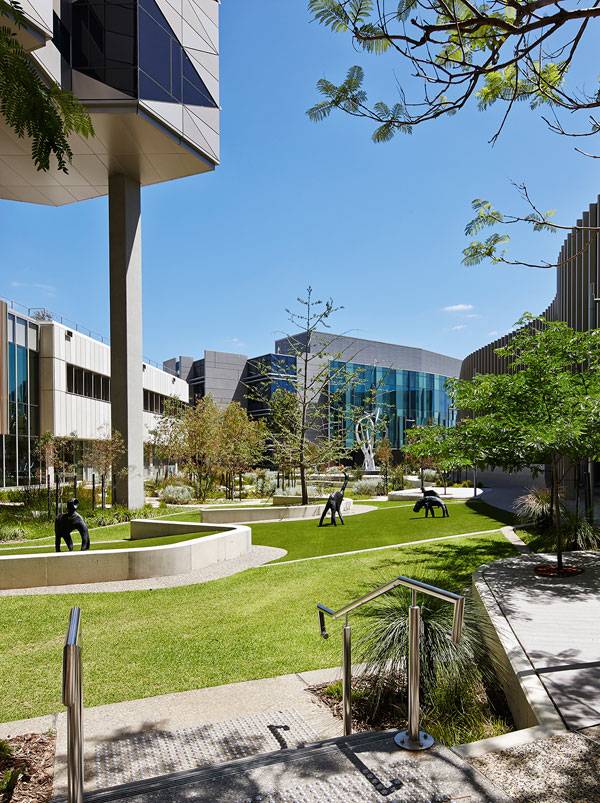
Fiona Stanley Hospital. Photo credit: Peter Bennetts
2. Trees Improve our Mental Health
It has long been recognized that trees and nature improve our spirits and mental wellbeing. More recently, getting outside in nature has been proposed as a specific antidote to the growing problems of attention deficit disorder and depression in children. We should take note of the Japanese practice of “forest bathing,” or Shinrin-yoku, where taking walks in the woods is used as a form of stress management and reconnecting with the greater world. WATCH >>> Real Fountain Of Youth | Forest Bathing
1. Trees Help us Decode History
Trees can also assist us in reconstructing the past through the advanced analysis of their tree rings. This is called the science of dendrochronology. Tree ring thickness is influenced by annual growing conditions, with warm, moist years producing wider growth rings, and cool, drought-filled years resulting in narrower growth rings. By looking at the pattern of growth rings across a region, historic climatic patterns can be reconstructed, giving us an intriguing glimpse into the past. Other useful applications of dendrochronology include the dating of historic wooden paintings, artifacts, and building materials, and complementing radiocarbon dating. WATCH >>> Lord of the Tree Rings – Science Nation
With the myriad benefits of trees, it seems like there is nothing that they can’t do! From reducing crime to helping us decipher history, trees are pretty astounding! For more remarkable tree information, be sure to check out our article, “8 Amazing Facts About Trees That You Didn’t Know,”.
What other amazing benefits of trees can you think of?
Remember: If you love trees than sign up to the LAN VIP Club – For every new VIP Member that signs up for an annual subscription, LAN will donate $2 USD to The Nature Conservancy’s goal to plant 1 BILLION trees worldwide.
Sign up HERE!
Article by Alexis Alvey
10 of the Best Tourist Spots for Landscape Architecture in Africa
Article by Sophie Thiel We explore 10 f the best tourist spots for landscape architecture in Africa and see what adventures await us. The word Africa conjures an image of vast landscapes of yellow savannas, the moist essence of broad rain forests, and the hot, dry air of the Sahara Desert. Africa is a continent with enormous natural abundance and richness in various ecosystems – some of them unique in the world. However, despite the fact that there are more than 300 national parks on this continent, most of Africa’s countries are still developing and are not known to be appreciative of the young profession of landscape architecture.

A herd of elephants in the morning in Serengeti National Park.By Bjørn Christian Tørrissen – Own work, CC BY-SA 3.0
Landscape Architecture in Africa
1. Canopy Walkway at the Kakum National Park – original idea by Joseph Dudley, in Ghana
If you manage to visit Ghana, don’t miss the Kakum National Park, known for its long series of hanging bridges at the forest canopy level that provide access to the forest. The canopy walkway of Kakum National Park is the oldest of its kind in the entire African continent. At a height of 40 meters, visitors can view plants and animals from a vantage point that would otherwise be inaccessible to humans. The canopy walkway passes over seven bridges and runs over a length of 330 meters. There are also six treetop platforms where you can rest, enjoy the spectacular views, and scout for the animal inhabitants of this equatorial rainforest ecosystem. Since the Kakum National Park is inhabited by seven primate species,including the rare Diana Monkey, and more than 500 species of butterflies and about 250 species of birds, the chances of an encounter with these animals are high.
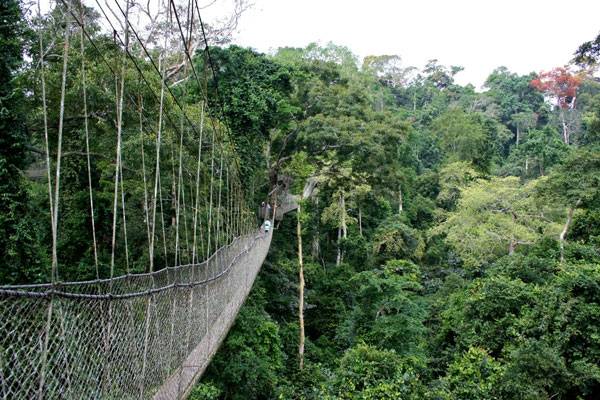
Kakum National Park – Kamum – Ghana Dicembre 2006 – Chiappi Nicola. By Original uploader was Chiappinik at it.wikipedia – Transferred from it.wikipedia, CC BY 2.5 it,
2. Walter Sisulu National Botanical Garden Johannesburg, Gauteng, South Africa
The Walter Sisulu Botanical Garden preserves the natural vegetation of the area that is known as the Rocky Highveld Grassland and consists of a mosaic of grassland and savanna, with dense bush in kloofs and along streams. The variety of habitats accommodates more than 600 naturally occurring plant species and is also home to an abundance of wildlife, with more than 220 bird species recorded on site. A few years back, a pair of majestic Verreaux’s eagles built their nest on the cliffs alongside the waterfall of Sisulu Botanical Garden. They come back to breed every winter – a great attraction for visitors. Since the garden has been voted the best place to get back to nature in Gauteng for nine years in a row – according to the South African National Biodiversity Institute – a visit to this site seems to really pay off if you stay in Gauteng area.
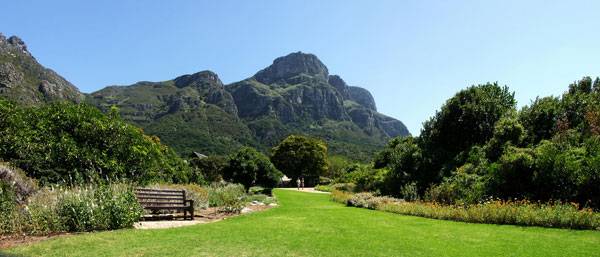
View of Table Mountain from Kirstenbosch Botanical Gardens. By Didier B (Sam67fr) – Own Work – Panorama made of 3 pictures taken by me, CC BY 2.5
3. August 7th Memorial Park – Nairobi, Kenya
This project is probably one of the oldest projects of modern African landscape architecture. It tells the tragic story of the car bombing of the United States embassy in Nairobi on Aug. 7, 1998, that killed 218 innocent people and injured thousands of others. The Memorial Park today functions as a tribute to the victims, but also as place of outreach to the public, to educate visitors on the appalling consequences of terrorism and violence and the need for peace, tolerance, and reconciliations. The small park comprises a landscaped garden, a wall commemorating the names of those who died, a sculpture made from the debris of the blast, and a visitor center.
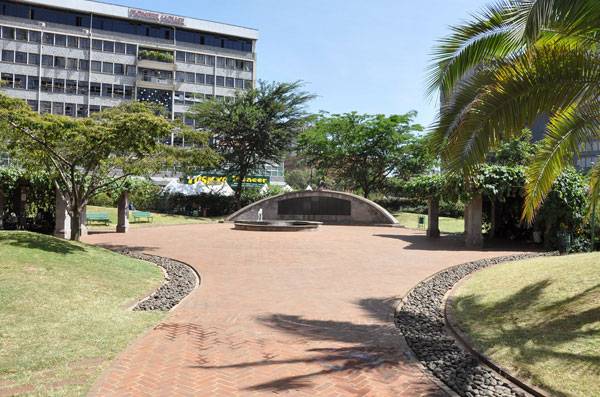
August 7th Memorial Park, via Flickr. Licensed under CC 2.0
4. Spring Festival – organized by Garden World, in Gauteng, South Africa
If you happen to visit South Africa in springtime, don’t miss the annual Spring Festival of Gauteng that runs between July 29 and Sept. 4. The exhibit is divided into four sections: forest, savanna, fynbos, and mountain ravine. This year, 22 gardens will compete for best in show. An additional highlight is the recreation of the Kirstenbosch South Africa Chelsea exhibit, which won Gold at the Chelsea Flower Show in London in 2016. Other annual attractions at the festival are the school gardens, children’s box gardens, and floral exhibits of the Gauteng Flora Union and Interflora. The whole event will surely delight both landscape architecture lovers as well as tourists who visit South Africa.
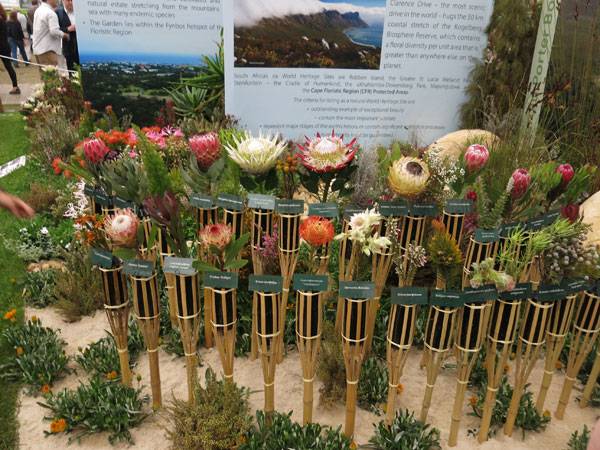
This picture shows an extract of this year’s Kirstenbosch South Africa Exhibit at the Chelsea Flower show. photo by Maria Schallar, 2016, private source.
5. Agodi Park and Gardens – by Earthworks Landscape Architects, in Ibadan, Nigeria
Agodi Park and Gardens has developed from an underused site to a promising leisure park that maintains environmental integrity. The team of designers focused on creating healthy outdoor activities within the unique savanna and forest environment of Ibadan.
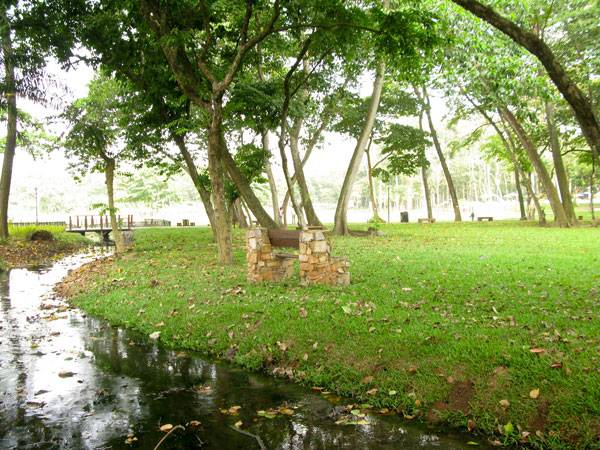
Agodi Park and Gardens. Photo courtesy of Earthworks Landscape Architects
6. Freedom Park – by Greeninc, in Pretoria, South Africa
Freedom Park is set up on the hill overlooking Pretoria – one of the three capital cities – offering visitors a panoramic view of the metropolis. Here, visitors are invited to keep watch over the maturing democracy and here, the story of Africa –and the liberation of South Africa and its people – is told. The local landscape architecture firm Greeninc designed Freedom Park to be a place of peace and growth. “[The] garden is a tribute to African and human dignity, and a place for the renewal of the human spirit…” the website says about the meaning behind this project. A mixture of architecture, landscaping, sculpture, archives, and imagery is used to distinctively explain the history and heritage of this region. This is truly a must-see project and one of the best examples of contemporary South African landscape architecture.
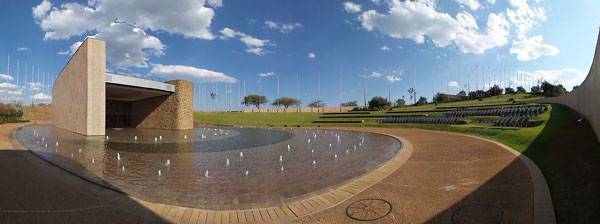
Freedom Park in Salvokop, Pretoria. By Leo za1 – Own work, CC BY-SA 3.0
7. Kirstenbosch Centenary Tree Canopy Walkway – by Mark Thomas Architects, in Cape Town, South Africa
The Centenary Tree Canopy Walkway, called Boomslang, in Kirstenbosch National Botanical Garden is a surreal, snaking bridge that creates a meandering, aerial path. By carefully hoisting the steel beams over the canopy, the designers were able to give people an amazing new way to appreciate the forest of the arboretum while causing minimal disturbance to the natural environment. Additionally, the Kirstenbosch National Botanical Garden clinched the top 2015 International Garden Tourism Award, crowning it as the best botanical garden in the world.

Kirstenbosch’s Tree Canopy Walkway. Photo credit: Adam Harrower
8. Al Azhar Park – by SITES International, in Cairo, Egypt
Al Azhar Park has risen like a phoenix, but from hills of trash instead of ashes. A great urban initiative helped to transform the site from a 500-year-old municipal garbage dump into a revitalized, natural public park with an array of amenities. The experienced designer team of SITES International insisted on integrating traditional Islamic landscape traditions in both the design and the choice of greenery, allowing the past flow of the city to come back to life. In addition to the environmental rehabilitation, a cultural and historical restoration was taking place, leading to a skillful use of the site’s location, elevated topography, and unique vistas overlooking dense, historic Cairo. Furthermore, Al-Azhar Park was named one of the 60 greatest places in the world by the renowned Project for Public Spaces. Does one need any more reasons to visit Cairo’s Al Azhar Park?
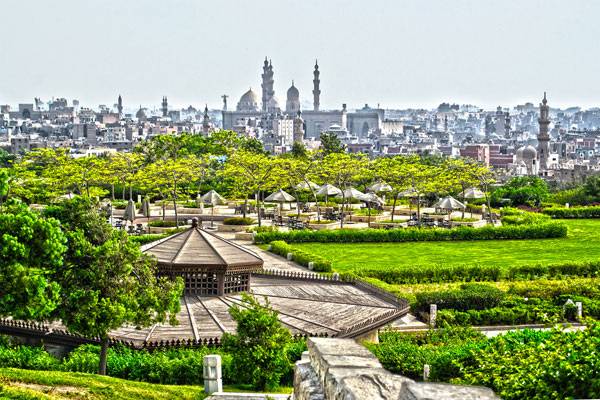
Al Azhar Park garden view. By Yasser Nazmi – Own work, CC BY-SA 3.0
9. Singita Lebombo Lodge – in Singita Game Reserve, South Africa
The line between the outside and the inside becomes blurred when it comes to exclusive lodging in national parks and game reserves throughout Africa. This is also the case in the Singita Lebombo Lodge, which lies in the Kruger National Park of South Africa. Here, architecture and its surrounding landscape merge into one joint object sharing materials and magnificent views. The Singita Lebombo Lodge offers its visitors the feeling of being one with nature, while at the same time scoring with its design choices. Lodges such as this are ideal for anyone who wants to get an ultimate, close-up experience with African national parks without relinquishing luxury and comfort.
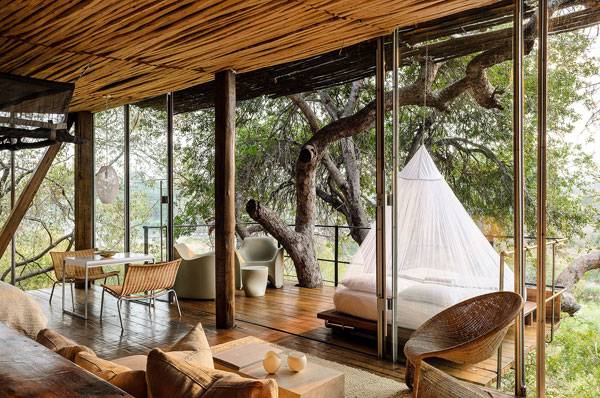
One of 15 loft-style suites at Singita Lebombo Lodge. Photo by Jessica138, source
10. Majorelle Garden – by Jaques Majorelle, in Marrakech, Morocco
Majorelle Garden is a real tourist magnet in Morocco, due to its fascinating design. The garden was created over decades by the artist Jaques Majorelle. On various trips around the world, he acquired hundreds of rare varieties of trees and plants, which he arranged between light and shadow around a long central basin and along irregular, meandering walkways with curved, painted walls. Majorelle had a particular liking for the use of primary colors, and it is those colors that transform his garden into a masterpiece. Nowhere else you can find this special shade of cobalt blue used as extensively as in Majorelle’s wonderful garden.
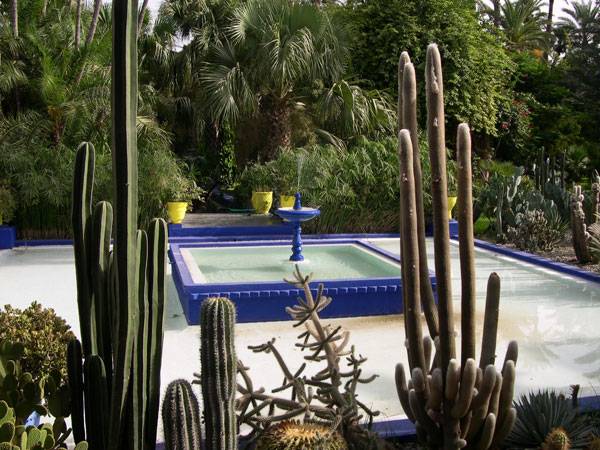
Jardin Majorelle. By No machine-readable author provided. Biniouze assumed (based on copyright claims). – No machine-readable source provided. Own work assumed (based on copyright claims)., CC BY 2.5
Recommended Reading:
- Becoming an Urban Planner: A Guide to Careers in Planning and Urban Design by Michael Bayer
- Sustainable Urbanism: Urban Design With Nature by Douglas Farrs
Article by Sophie Thiel
How Innovative Design Reinvents the Jewelry District
Article by Erisa Nesimi The innovative design of the Jewelry District Public Realm by !melk landscape architects in Providence, Rhode Island, USA Rethinking the design of a public space is not at all easy. You are confronted with a complexity of aspects to be considered, where one of them is sure to be the historic layers the site holds. This is the case of the Jewelry District in the heart of Providence. !melk landscape architecture & urban design shows a first-rate model on how to deal with a comprehensive design in an innovative way. The relocation of Interstate Highway 95 created an opportunity for the Jewelry District to reinvent itself, while also offering a chance for Brown University to expand its Medical School from their current college hill campus into downtown Providence, engaging the riverfront, the neighborhood in their environments.

©!MELK
Innovative Design With !melk landscape architects
The landscape architects came up with a design which, other than fulfilling the needs of the university, also becomes a gathering space for people nearby. !melk was commissioned to generate ideas for this project, which was a multi-phase public space master plan. The site includes a variety of spaces, a rich-in-history urban plaza, a waterfront park with a streetscape design and a pedestrian bridge. !melk’s design is comprehensive because it evokes the history of the place. The site is called the Jewelry District, and it used to have a significant role for Providence. It was once a thriving mercantile area with warehouses and manufacturing buildings as well as its own harbor.
Bringing the Pieces of History Together
The designers’ take on the project was, for the most part, about bringing the pieces of history together. For instance, great attention was shown to the connection with the water and its particular meaning to the place. Furthermore, the Jewelry District used to be a magnet point for the city, full of fascinating features such as cobblestone streets and beautiful old buildings which create a cozy atmosphere. Unfortunately, what they found there when they first started the project was a huge, ugly parking lot.

©!MELK

©!MELK
Building a Variety of Spaces and Functions
What !melk studio designed includes a variety of spaces, a continuum of planned and existing environments. It acts as an example of a scattered urban plaza. The three main points are the bridge, the riverbank parks, and the urban plaza in the heart of Providence. The bridge, with its undulating form, not only serves as the connection with the Brown Campus, but also as a public piazza in itself. Besides being a circulatory space, it is an amphitheater with a marvelous view towards the river.

©!MELK

©!MELK
The Bridge and its Innovative Design
This comes as a result of the curvilinear shapes in conjunction with the change of levels in the bridge. Particular emphasis was given to placing the bridge at the last remaining slip of the former harbor; at the eastern terminus of Ship Street – stressing the emphasis on the city’s history. Remarkable is the fact that the bridge is designed on top of existing footings of the removed Interstate Highway 95. The spectacular shape of the bridge produces the possibility for a dynamic public space not only in the bridge, but also along the riverbanks. The designers allocated close attention to this detail by generating design concepts for both the eastern and western banks.
An Inspiring Use of Landscape Materials
Rather than one specific urban plaza, this project is a conglomerate of a variety of urban and landscape elements where each of them holds its own unique character but they’re also interconnected amongst each-other. An essential feature that unites all of the spaces is the consistency of the applied materials, such as the wood decking and the cobblestones. The paving stone is the main representative of the effort the designers have put into the project.

©!MELK

©!MELK
The Use of Planting in the Design
Greenery is crucial throughout the whole design where trees are present even on the pedestrian bridge. Both riverbanks are treated with green features and the design is so carefully considered in each specific detail, such as the tree grates, which assembled with an eye-catching intricate design, obtained the name “the jewel of the Jewelry District”.

©!MELK
Inspired Landscape Lighting Scheme
Just when you think that was it with details, you are yet again surprised by the ingenuity of the designers. Also designed specifically for this project and fitting perfectly to their purpose, the lighting devices are another wonderful facility completing the project. Due to their special design, they are innovative and flexible, resulting in an optimal lighting of the space in the night hours.
Events and Activities at the Jewelry District
The square provides a main public space which, just like the old Jewelry District, can host an array of activities such as farmers’ markets, food truck vendors, outdoor film events, and a series of other entertainments.

©!MELK

©!MELK
Full Project Credits For Jewelry District Public Realm :
Project: Brown University’s Jewelry District Public Realm, Providence, Rhode Island, USA Client Reference: Brown University Mr. Michael McCormick Vice President Planning, Design, Construction Box 1941 Providence, RI 02912 Michael_McCormick@Brown.edu 401-863-7883 Year: Current (first phase completion scheduled September 2011) Cost: $ 2,000,000 (first phase public spaces) $ 6,000,000 (bridge) Recommended Reading:
- Becoming an Urban Planner: A Guide to Careers in Planning and Urban Design by Michael Bayer
- Sustainable Urbanism: Urban Design With Nature by Douglas Farrs
Article by Erisa Nesimi
How to Blend Nature and Design for Better Living
Article by Mai Nguyen Burasiri Beuing nong kod is a design for better living, by Shma Company Limited, in Khon Kaen, Beung NongKod, Thailand Another project by Shma Company was just completed in Khon Kaen, one of the four biggest cities in eastern Thailand. By making good use of topography and other traditional images, the project has enhanced the value of the residential project and made it an interesting destination. As constantly highlighted in many urban design theories, the importance of public spaces in a residential arrangement is undeniable. A well designed public space fosters a good quality of living. In this project, the Burasiri park is ideally placed at the heart of a residential zone, maximizing its accessibility for its citizens. Moreover, with a unique and interesting landscape design, the park has become an amazing community destination.
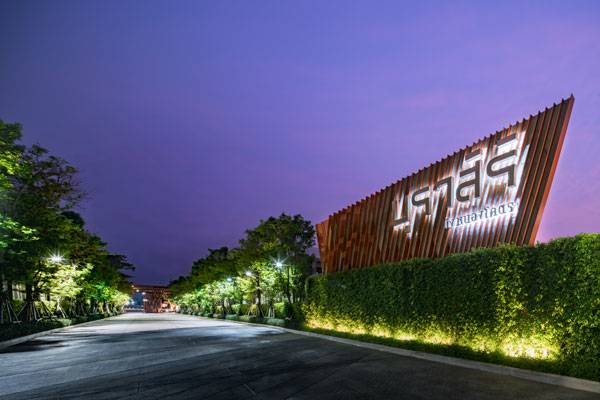
Burasiri Beuing nong kod. Photo credit: Wison Tungthunya
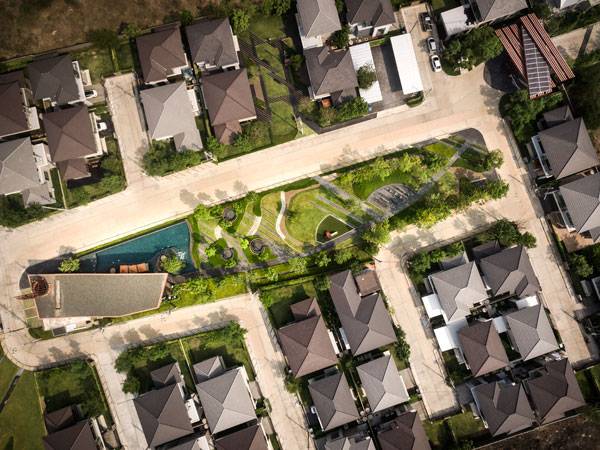
Burasiri Beuing nong kod. Photo credit: Wison Tungthunya
Design for Better Living
The Attraction of Local Specialties
The very first image of this residential project is an amazing design for the entrance: a unique village label that has been applied to the gate design with numerous sophisticatedly overlapping frames like a weaving of steel. This creates a strong yet silky first impression for visitors. Indeed, the design was inspired by one of Thailand’s unique sculptures and is enhanced through a harmonious combination of evergreen shrubs, lighting, and eye-catching color. This intertwining solid-frame “trick” also creates an interesting visual effect when the sunlight weaves patterns of shadows on the ground.
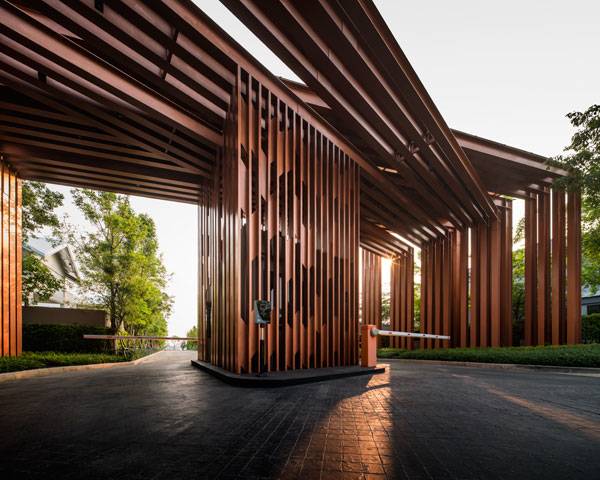
Burasiri Beuing nong kod. Photo credit: Wison Tungthunya
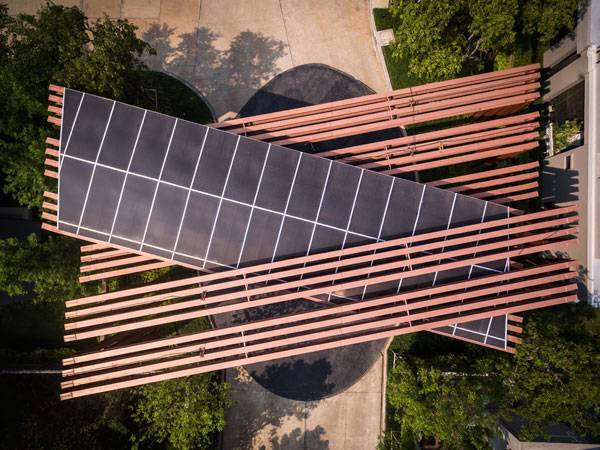
Burasiri Beuing nong kod. Photo credit: Wison Tungthunya
A Graceful First Introduction Told Through Green Scene and Scent
The park is integrated with different public facilities, such as swimming pools, playgrounds, and a gym, to name but a few. These follow a structural storyline connected by a walking path that follows the changes in topography, creating an interesting experience for users enjoying the landscape design. Interestingly, the park’s drop off zone is not right next to the entrance gate. Visitors have to walk along the whole length of the park before reaching its starting point and being amazed by the welcoming view of the gym and swimming pools area.
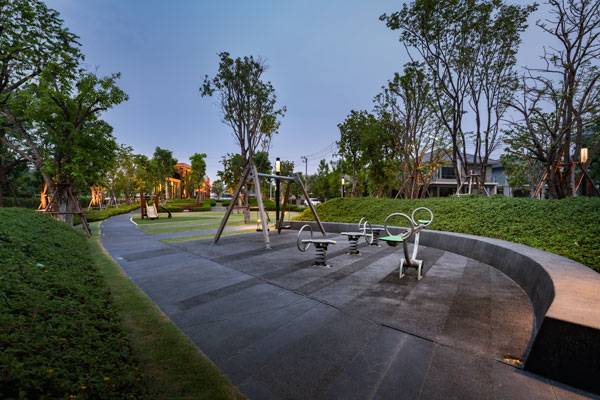
Burasiri Beuing nong kod. Photo credit: Wison Tungthunya
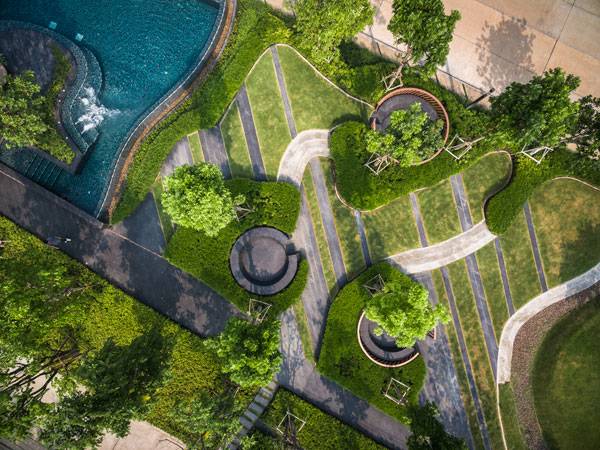
Burasiri Beuing nong kod. Photo credit: Wison Tungthunya
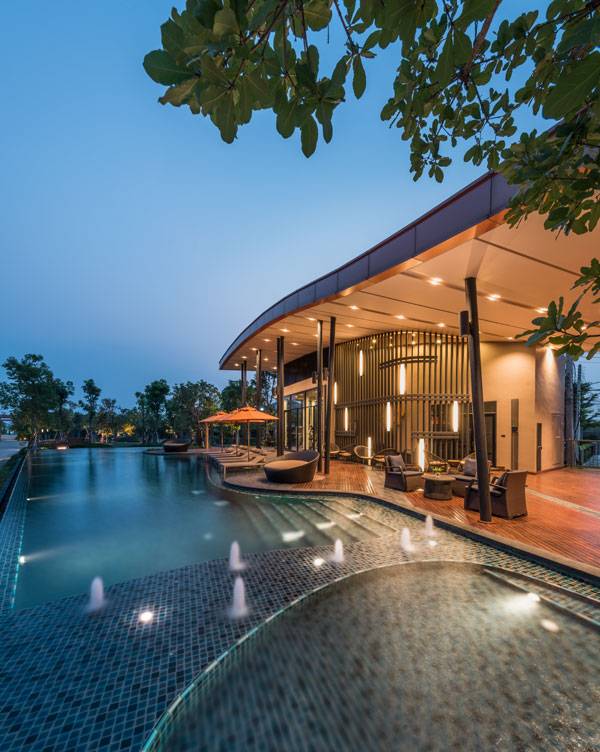
Burasiri Beuing nong kod. Photo credit: Wison Tungthunya
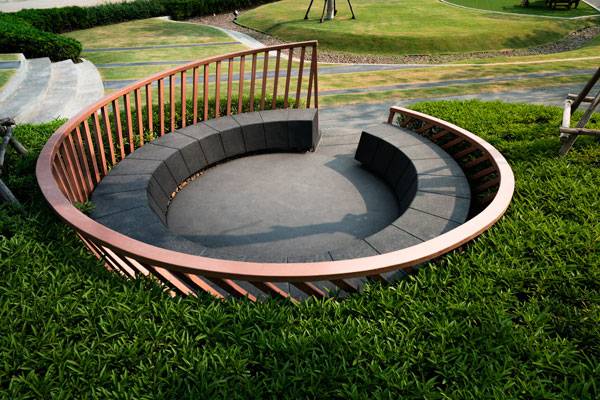
Burasiri Beuing nong kod. Photo credit: Wison Tungthunya
A Sporty Environment and Enriching Privacy Experiences
The very first destination of the park is the gym, which is integrated with the modern-shaped swimming pool and a Jacuzzi. The level of this sports area is elevated, not only because it is the main attraction of the park, but also to generate more interesting views for fitness users. The selection of appealing color for the gym reminds visitors of the color concept of the entrance gate. The whole project follows a consistent design language. By using clear glass for the gym, a comprehensive sport based environment is created for both indoor and outdoor activity spaces. Indeed, the shapes of the gym and the swimming pool are gracefully matched, establishing an interesting place for “keeping fit”. Connected with the swimming pool, but isolated in an “under the tree” space at one edge of the pool, the Jacuzzi is definitely a nice place to relax and enjoy a massage. One of the most interesting points of the gym area design is the reasonable use of level changes and the arrangement of its components with privacy as a priority. Users can experience socially exciting spaces or private and peaceful spaces, all at the same place.
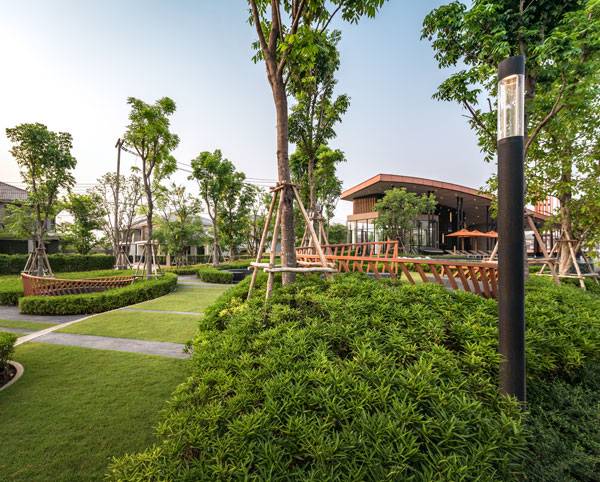
Burasiri Beuing nong kod. Photo credit: Wison Tungthunya
Creating Harmony with Nature
The second stop in the park is the gathering area, with its unique design of resting benches inspired by fish traps, also a familiar image of Thai culture. The design of the benches also follows the concept of the entrance gate, with an outstanding look that still embraces the surrounding shrubs and walking path. However, there might be a question about users’ comfort when using the color black and a rough surface in a tropical area such as Thailand.
Blending Nature and Play
Last but not least in the journey of exploring the park is a playground surrounded by artificial grass mounds. For children, this design creates a feeling of blending in with nature; the selection of plants that bloom yellow in late spring also enriches the experience of landscape design in time.

Burasiri Beuing nong kod. Photo credit: Wison Tungthunya
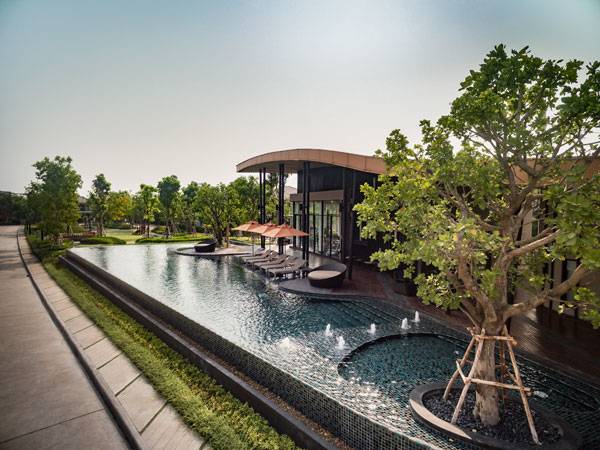
Burasiri Beuing nong kod. Photo credit: Wison Tungthunya
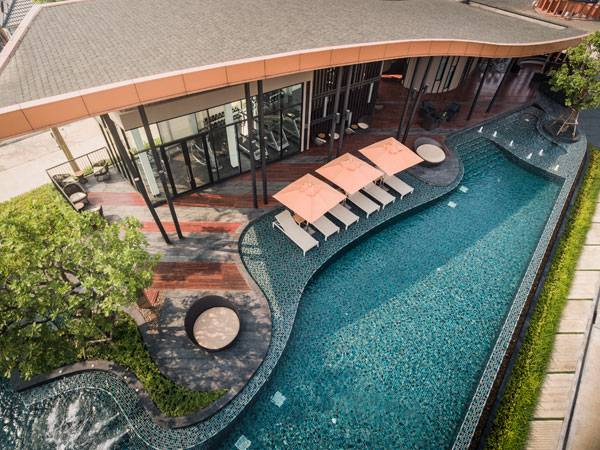
Burasiri Beuing nong kod. Photo credit: Wison Tungthunya
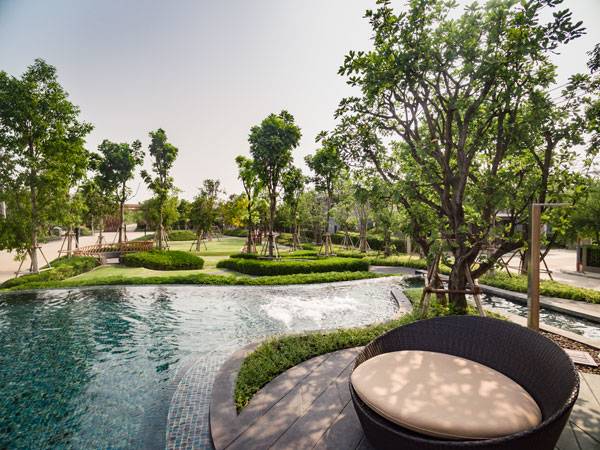
Burasiri Beuing nong kod. Photo credit: Wison Tungthunya
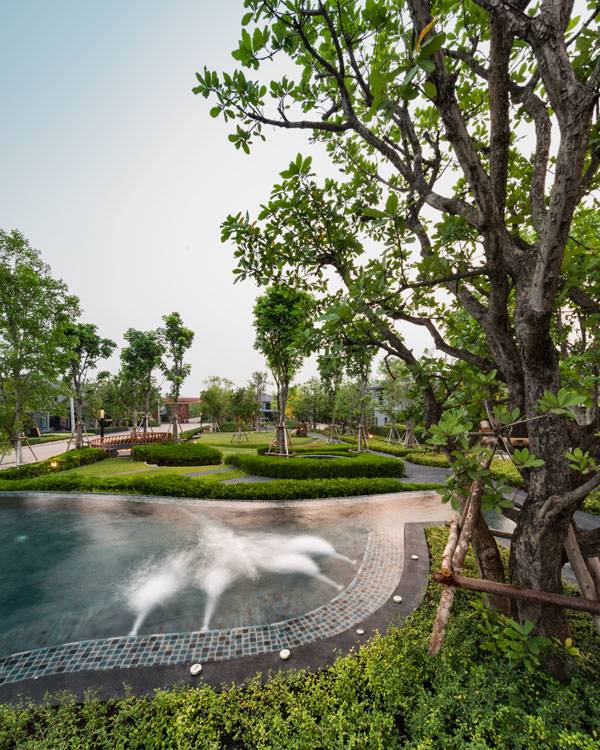
Burasiri Beuing nong kod. Photo credit: Wison Tungthunya
Full Project Credits For Burasiri Beuing nong kod :
Project Name: Burasiri Beuing nong kod Landscape Architect: Shma Company Limited Project Team: Design Director: Yossapon Boonsom Senior Landscape Architect: Worawe Jamsomboon Landscape Architect: Piyawut Koomsiripithak Horticulturist: Pornsiri Rodkul Client & Developer: Sansiri Architect: DB Studio M&E: VGroup C&S Engineering: Site83 Site Area: 18,990 square meters Completion Year: 2015 Location: Khon Kaen, Beung NongKod, Thailand Photography Credit: Wison Tungthunya Landscape Budget: 7.08mb Recommended Reading:
- Becoming an Urban Planner: A Guide to Careers in Planning and Urban Design by Michael Bayer
- Sustainable Urbanism: Urban Design With Nature by Douglas Farrs
Article by Mai Nguyen
10 Reasons Why You Should Choose a Career in Landscape Architecture
Article by Jeanne Connolly Thinking about a career in Landscape Architecture ? Are the years of studying, research, and projects worth it? Yes! And this is why it will pay off! As we move into a future of sustainability and the need for energy-efficient resources, landscape architecture has become a key to the future of design. Trained with a wide range of skills that combine art and science, the opportunities are endless for landscape architects. With a creative eye and environmental awareness, landscape architects design to improve everyday life. Still wondering if landscape architecture is right for you? Or need more assurance that you are going in the right direction? Maybe these 10 reasons will make you more confident with choosing landscape architecture!
Career in Landscape Architecture
1. Creative Career Path
Creativity pushes us to think and work without boundaries, in turn creating endless solutions and more productive thinking. Good design requires a lot of creativity, thought, and several solutions before you find “the one.” As a landscape architect you will keep your creative mind running throughout your entire career. To boost creativity, landscape architects also collaborate with one another and even other design fields such as architecture and engineering, adding the benefit of several different ideas.
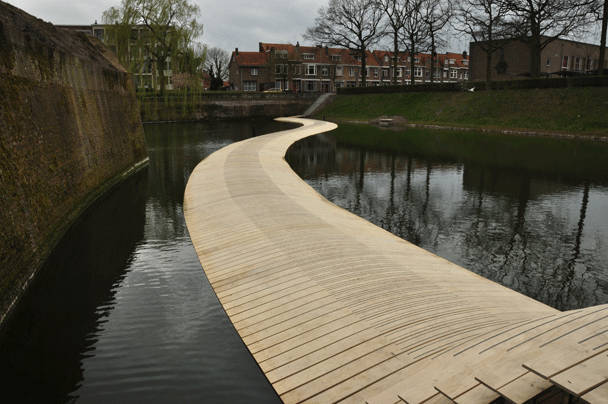
Photo Credit: RO&AD This creative solution for the Raveijn Bridge by RO&AD is designed to adapt to climate changes. The floating bridge rises and falls in accordance with the changing water levels.
2. Versatile
From urban design to interior landscapes, landscape architects are trained with a wide range of knowledge that gives them several different areas of employment opportunity. The design is not the only important aspect of landscape architecture either. Research, data analysis, planning, and management are all important areas of expertise as well as aesthetics. As a landscape architect you could find yourself working in any of these areas: parks and recreation, urban design, residential design, hospitality and resorts, educational campuses, therapeutic gardens, wildlife reserves, conservation, historic preservation, commercial design, land art, interior landscapes, monuments, and much more. Related Article: 10 Niches you can Carve out of Landscape Architecture to Make a Name for Yourself
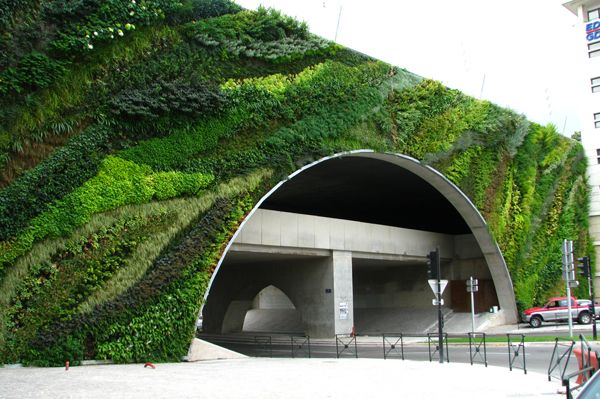
Photo Credit: Patrick Blanc Landscape Architects also combine different elements such as structure and planting design, as seen in this Green Wall.
3. Variety of Mediums
Landscape architects use about every form of creative media, from hand drawing to digital rendering. There is room for all artistic skills whether you specialize in working with your hands or your computer mouse. Related Article: Is Drawing a Natural Talent?
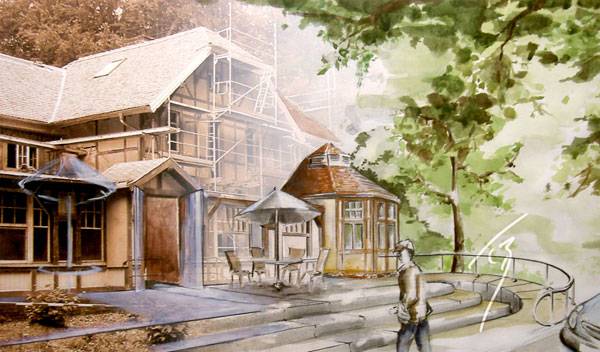
Photo Credit: Tino Beck A skillful combination of photography and hand rendering by Tino Beck. Featured in Sketchy Saturday | 32
4. Design for Healthier Lives
The landscape architecture practice follows the ASLA Board of Trustees’ “ASLA Code of Environmental Ethics” on asla.org, in which the preamble states, “Members of the American Society of Landscape Architects should make every effort within our sphere of influence to enhance, respect, and restore the life-sustaining integrity of the landscape for all living things.” Landscape architects strive to not only create intriguing places, but healthier environments for the general public. In Peter James and his cohorts’ study, “Exposure to Greenness and Mortality in a Nationwide Prospective Cohort Study of Women” in Environmental Health Perspectives, they linked residential greenness and mortality rates. They found the cumulative average seasonal greenness around 108,630 women’s addresses using data from US-based Nurses’ Health Study prospective cohort and satellite imagery from Normalized Difference Vegetation Index (NDVI). Related Article: 5 Top Health Benefits of Landscape Architecture
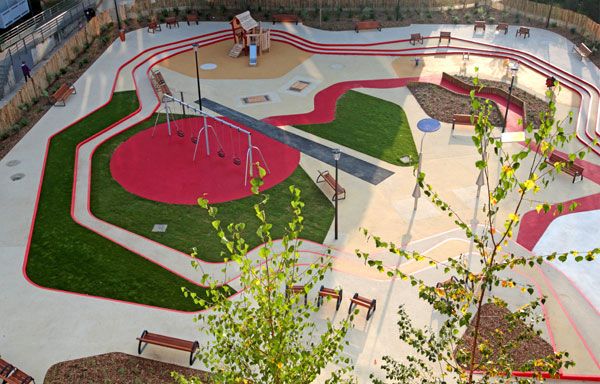
Photo Credit: Espace Libre A Toddlers Playground in Alfortsville, France, was designed to stimulate creativity for children in their early years of learning development.
5. Designing With Natural Elements
The use of plants as a material differentiates landscape architecture from other design areas and the combinations are endless. Material selection is also based on environmental impact along with aesthetics. Landscape architects take what is natural and design solutions that are both creative and environmentally beneficial. Related Article: 10 Projects That Make Excellent use of Planting Design
6. Historic Preservation
The cultural experience of a place roots deep in its history. Preserving that history is very important in keeping community culture alive. Through each project, landscape architects research heavily into the history of their site, and make sure to preserve and elaborate on what should not be left behind. Related Project:The Lakewood Garden Mausoleum by: HGA Architects
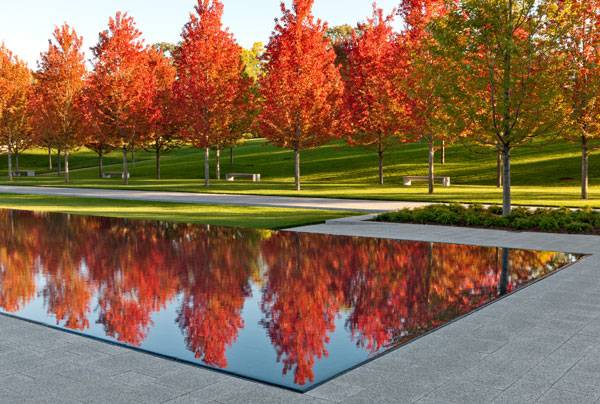
Photo Credit: Paul Crosby A modern approach to preserving the Lakewood Garden Mausoleum.
7. Wildlife Conservation
For the animal lovers, conserving and protecting wildlife is an important part of landscape architecture. Not only on wildlife reservations, but in almost all projects, landscape architects use conservation design practices, thoughtful plant palettes, and a lot of research to conserve and create wildlife habitats. Related Project: Reflecting on the Past While Looking Forward to the Future With Wildlife Conservation
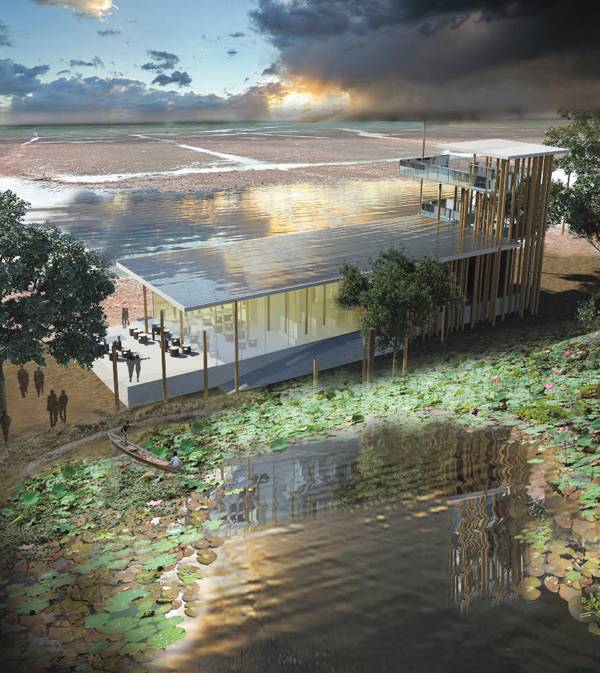
Photo Credit: And Trapeang Thmor Memorial Crane Reserve Press Release Building Trust International and the Wildlife Conservation Society (WCS) collaborated on an interpretation centre at Ang Trapeang Thmor Wildlife Reserve.
8. Sustainable Design
As climate change has already begun, it has become a prominent issue that design must adapt to. By using sustainable solutions, landscape architects intend to combat climate change and create environmental solutions that last years into the future. Sustainable solutions that landscape architects design include: green roofs, storm water management, rain water harvesting, rain gardens, etc. Related Project: Copenhagen’s First Climate Resilient Neighborhood
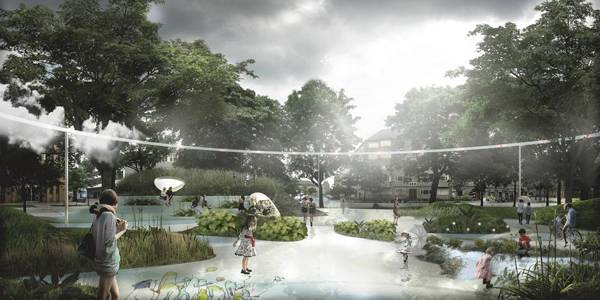
Photo credit: tredjenatur.dk Storm water management practices are used to fix the flooding problem in St. Kjeld, Osterbro.
9. Community Involvement
Landscape architects create people-oriented design that speaks to the community and improves their experience. Landscape architects are often involved in town hall meetings and public surveys in order to find out what the community actually wants and needs. It gives you a chance to get involved with the community and make an impact on their outdoor experience. Related Project: How Mesa City is Giving us a Great Lesson in Public Participation
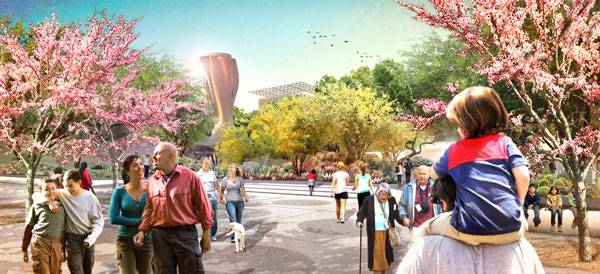
Photo credit: Colwell Shelor, West 8, Weddle Gilmore A public landmark in Mesa City designed to increase the quality of pedestrian life.
10. Relatable to Everyone
From the minute you walk out the door in the morning, you are experiencing landscape architecture. Some of our most memorable experiences have to do with a certain place or view outside. It is more than the design of spaces, but designing places of experience that people can relate to globally.
Are you up for the Challenge of a Career in Landscape Architecture ?
Landscape architecture combines art and science to improve not only the environment, but our everyday lives. You have the opportunity to make an impact on the world’s experience of outdoor spaces as a landscape architect, and have endless ways and places to do so. It’s only up to you now. Are you up for the challenge?
Recommended Reading:
- Becoming an Urban Planner: A Guide to Careers in Planning and Urban Design by Michael Bayer
- Sustainable Urbanism: Urban Design With Nature by Douglas Farrs
Article by Jeanne Connolly
Top 10 Flowering Perennials to Brighten Any Rain Garden
Article by Alexis Alvey We explore 10 flowering perennials to brighten up any rain garden, enabling you not only to create sustainable landscapes but beautiful ones too. Rain gardens can beautifully enhance a variety of landscapes, from homes to parking lots to street curbsides. Created in low spots in the garden, rain gardens mitigate localized flooding and enhance local water quality by collecting and filtering excess rainwater. Plants for rain gardens must therefore be carefully selected to grow and thrive under both saturated and dry conditions. Appropriate flowering herbaceous perennials work well in rain gardens and can add bright pops of color seasonally or year-round. Suitable ornamental grasses — and even trees and shrubs, if enough space is provided — can also be incorporated into a rain garden.
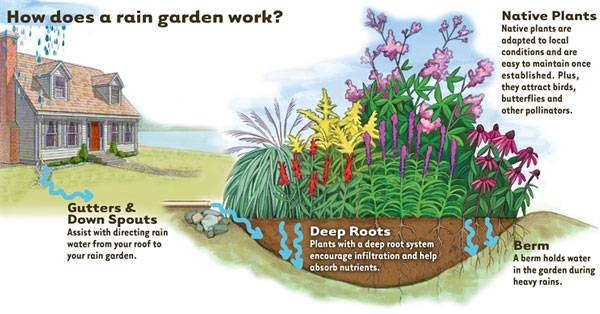
From the article Rain Gardens: The Essential Guide
10 Flowering Perennials
Below are 10 flowering perennials that add exceptional beauty and function to rain gardens. When choosing from this list, be sure that the perennial can thrive under your climactic conditions and that the plant is not invasive in your region. In order to support local pollinator populations, give preference to plants that are native to your area. Also, when designing your rain garden, be aware of where you will be placing each plant — species planted at the bottom of the basin need to be more tolerant of saturated soil conditions than those planted closer to the rim of the basin.
![RBC Rain Garden at the London Wetland Centre Nearly a year after it opened the Rain Garden (funded by the Royal Bank of Canada) is maturing well. In the photograph is one of the creature towers to provide habitats for insects and small mammals. They have been put together with a variety of materials from slates to sticks. Creative Commons Licence [Some Rights Reserved] © Copyright Marathon and licensed for reuse under this Creative Commons Licence.](https://land8.com/wp-content/uploads/2014/08/Rain-gardens2.jpg)
RBC Rain Garden at the London Wetland Centre Nearly a year after it opened the Rain Garden (funded by the Royal Bank of Canada) is maturing well. In the photograph is one of the creature towers to provide habitats for insects and small mammals. They have been put together with a variety of materials from slates to sticks. Creative Commons Licence [Some Rights Reserved] © Copyright Marathon and licensed for reuse under this Creative Commons Licence.
10. Blue Flag Iris (Iris versicolor and I. virginica)
Both native to the United States, Northern Blue Flag Iris (Iris versicolor) and Southern Blue Flag Iris (I. virginica) can take winter temperatures of -40˚F (-40˚C) and -20˚F (-29˚C), respectively. Blue Flag Iris has showy seasonal flowers that can range from pale blue to deep violet. Mature height and spread of Blue Flag Iris is around two feet. Native to wet meadows and marshes, Blue Flag Iris grows best in full sun and can grow in standing water for protracted periods of time, so plant at the bottom of your rain garden.
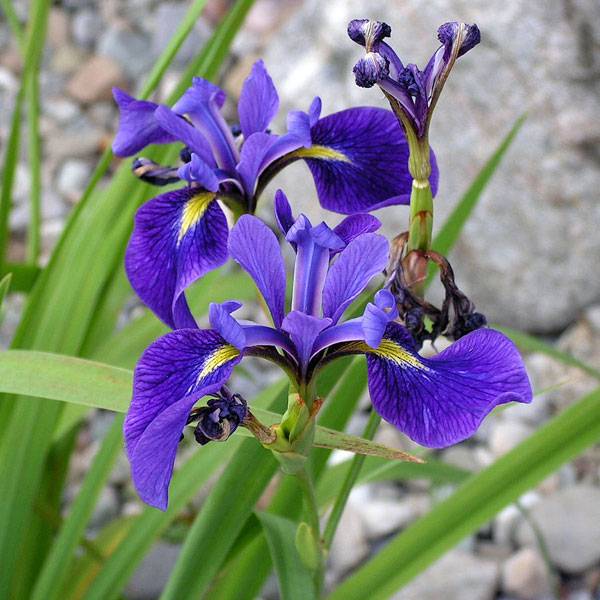
Northern Blue Flag (Iris versicolor), Ottawa, Ontario. By D. Gordon E. Robertson – Own work, CC BY-SA 3.0
9. Joe Pye Weed (Eutrochium purpureum)
Joe Pye Weed is native to the eastern United States and can tolerate winter temperatures of -30˚F (-34˚C). Atop tall green stems, dusty pink flowers bloom, which are highly attractive to butterflies. Joe Pye Weed can reach seven feet tall by four feet wide, although smaller cultivars also exist. Plant in full sun or partial shade. Joe Pye Weed is native to wet meadows and stream sides and likes consistently moist soil, so plant toward the bottom of your rain garden.
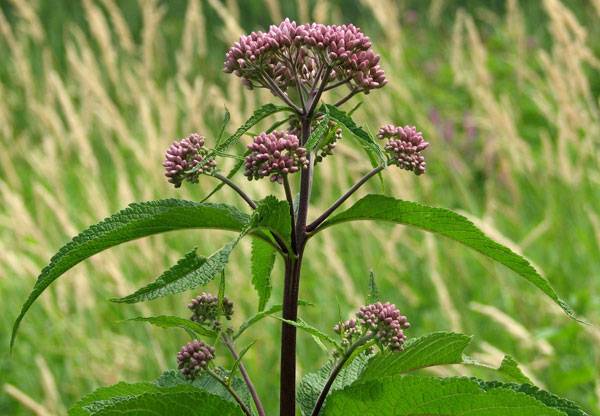
By D. Gordon E. Robertson – Own work, CC BY-SA 3.0
8. Canna Lily (Canna spp.)
There are many exquisite cultivars of Canna Lily available today that have been developed from species native to the subtropical and tropical areas of South America. Bold and brightly colored, Canna Lilies grow from rhizomes that can be dug up and stored over winter in a cool, dry basement in areas that get temperatures below 0˚F (-40˚C). Intense red, orange, pink, or yellow flowers with large, paddle-shaped foliage lend a tropical feel to the rain garden. Canna Lily can grow quite tall — up to eight feet depending on the cultivar — and can spread four feet. Plant in full sun. If your rain garden is saturated most of the time, try Canna glauca, a water-loving Canna Lily.
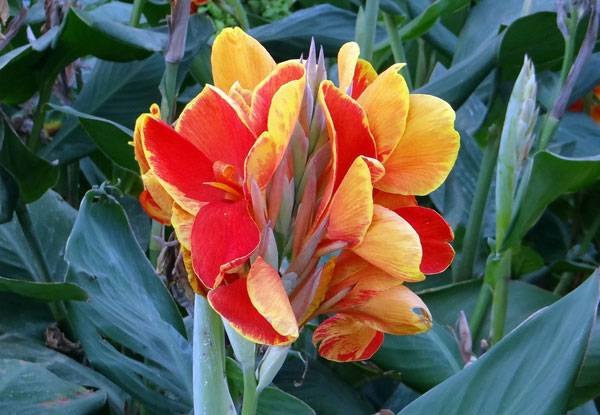
CC0 Public Domain. Source.
7. Bluestar (Amsonia hubrichtii)
Bluestar is native to the south-central United States and thrives where winter temperatures generally don’t dip below -20˚F (-29˚C). Powder blue, star-shaped flowers appear seasonally in clusters atop feathery, green foliage. Bluestar is attractive to butterflies and grows best in full sun to part shade. Mature height and spread of this soft-textured perennial is two to three feet. Bluestar can tolerate drier conditions better than many of the other plants on this list, so plant near the top of your rain garden.
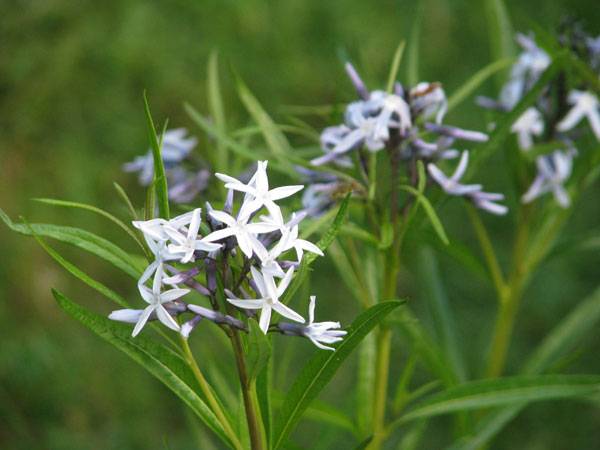
Amsonia hubrichtii hybrid. By peganum from Small Dole, England – Amsonia hubrichtii hybrid, CC BY-SA 2.0,
5. Butterflyweed (Asclepias tuberosa)
Butterflyweed is also native to the eastern United States and can tolerate winter temperatures of -40˚F (-40˚C). It is known for its brilliant orange seasonal flowers and its ability to provide for monarch butterfly larvae. Be sure to plant this deep-rooting perennial in full sun. This plant is smaller than Swamp Milkweed, reaching a height of one to two and a half feet and spread of one to one and a half feet. It is also more tolerant of dry conditions, so plant at the top of your rain garden.
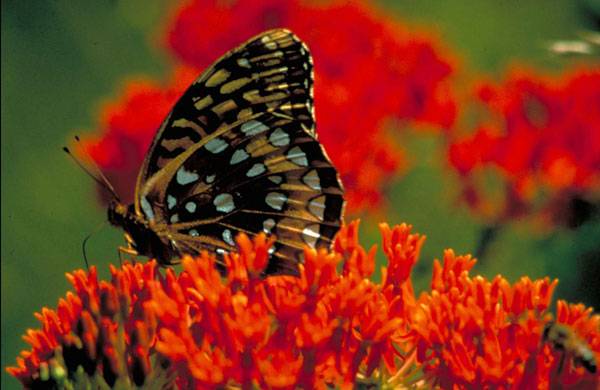
By Barnes Dr Thomas G, U.S. Fish and Wildlife Service
4. Daylily (Hemerocallis spp.)
Like Canna Lily, many lovely cultivars of Daylily exist, which have been developed from species native to eastern Asia. Daylilies will thrive in areas that experience temperatures no colder than -40˚F (-40˚C). Brilliant flowers range in color from clear yellow to orange to red and bright pink. Most Daylilies grow to about two feet tall and wide and will still flower profusely in partial shade. Even when not in flower, Daylilies provide nice texture in the rain garden with their narrow, fountain-like leaves. If you live in a tropical environment, try Spider Lily (Hemerocallis latifolia) in your rain garden.
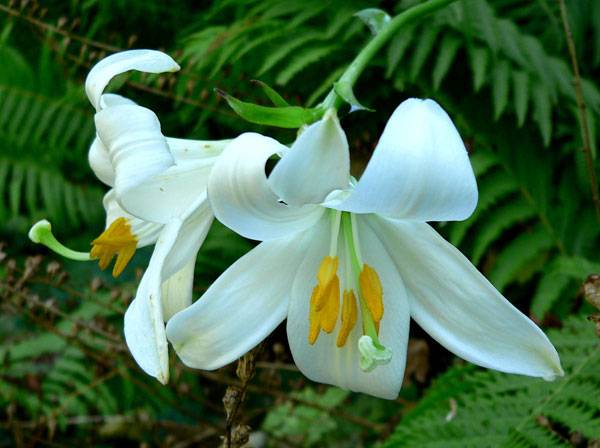
By Stan Shebs, CC BY-SA 3.0
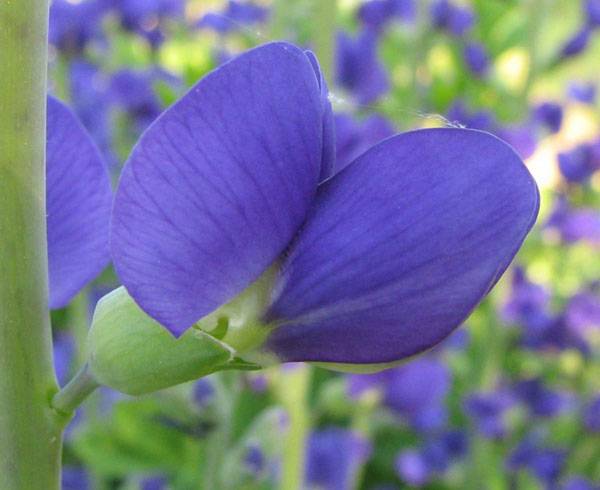
CC BY-SA 3.0, source
2. Swamp Sunflower (Helianthus angustifolius)
Swamp Sunflower is native to the eastern United States and grows well in areas where winter temperatures don’t dip below -10˚F (-23˚C). A profusion of cheery, golden-yellow flowers brightens any rain garden. Swamp Sunflower does best in full sun and is salt tolerant, which makes it useful for coastal locations. Native to swamps and wet pinelands, Swamp Sunflower can tolerate saturated soil for extended periods of time, so plant at the bottom of your rain garden.
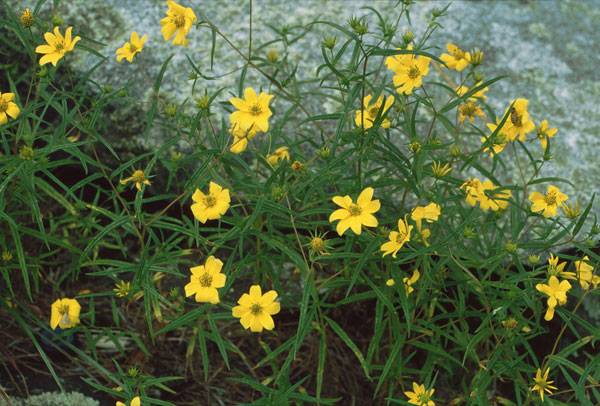
By Franz Xaver – Own work, CC BY-SA 3.0,
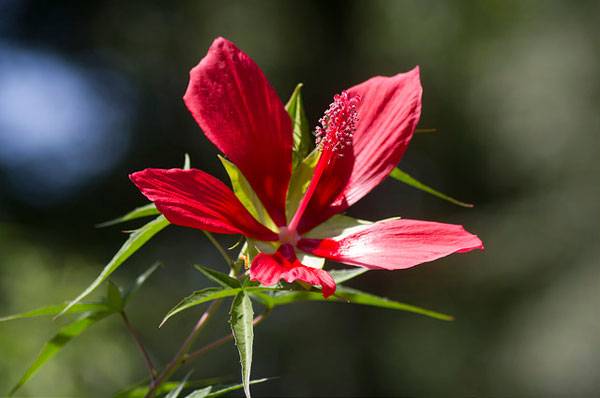
Photo credit: ilouque via Flickr and licensed under creative commons 2.0
For more information on rain garden construction, check out our article, “Rain Gardens: The Essential Guide”. Recommended Reading:
- Rain Gardens: Sustainable Landscaping for a Beautiful Yard and a Healthy World by Voyageur Press
- Rain Gardens: Managing Water Sustainably in the Garden and Designed Landscape by Timber Press, Incorporated
Article by Alexis Alvey
Is This the Best Landscape Architecture App ?
Article by Aybige Tek What’s out there in terms of a landscape architecture app for the profession ? We take a closer look at Pl@ntNet and explore its capabilities. The smartphone application Shazam has solved a lot of problems for those of us trying to identify the name or artist of a song we hear playing when we are out and about. What if there were a Shazam for plants? These is – it’s called PlantNet. Download the application with its tiny green leaf logo and get started.
What is Pl@ntNet?
Pl@ntNet is a crowd-sourced data application for iOS and Android systems that features the collaboration of both horticulture experts and regular people who just want to know what plants they are looking at. Farmers, foresters, hikers, mountain climbers, ecologists, researchers, botanists, landscape architects, and customs officers are among those who find it helpful. Users share images and make contributions to a global plants platform. The app’s visual recognition program identifies plants by referencing a world botanical database. In July 2016, this application already had more than 44,700 plants listed, including pictures of 900 species. Users can save searches in their observation folders, so their images are recognized and defined by this application system. Also, plants are listed in alphabetical order, like in an encyclopedia. This is done in two sections: families of plants and species of plants. WATCH >>> Pl@ntNet Mobile App (ACM Multimedia 2013 Demo Track)
Here are Some Other Frequently Used Plant Apps
There are some similar applications that identify plants and flowers, such as Plantsnap, LikeThatGarden, Flower Checker, Plantifier, Leafsnap, NatureGate, Ipflazen, and GoogleGoggles. Each is known for a particular specialty:
- Plantsnap: Lets us identify and buy the plants.
- LikeThatGarden: Lets us identify plants and also shows us similar plants.
- Flower Checker: Real botanists help us to identify plants and also moss, fungi, and lichen.
- Plantifier: People from mygarden.org identify plants.
- Leafsnap: Identifies trees.
- NatureGate: Identifies plants, fish, birds and even butterflies.
- Ipflazen: Identifies plants and flowers.
- GoogleGoogles: This is not directly about plants. However, some examples identify plants and work from the image.
How Is Pl@ntNet Different?
First of all, we download the application and see its logo. When we press the logo, we are welcomed with four regions of the planet Earth: Western Europe, Indian Ocean, South America, and North Africa We can either load an image of the plant we are searching for and wait for its recognition, or we can go from the name of the plant to get more information about its region and qualities.The application also connects to Wikipedia for the basic definition of the content data of plants. If the images that are taken show in detail the organs of the plants, the result is easier to obtain. The whole application creates the big picture of the evolution of plants in the whole wide world. This makes this application almost the best – it’s just missing North America. When a user takes a photo of a plant he wants to identify, the application gives options to choose from, such as leaf, flower, fruit, or bark. The more images taken, the more information can be accessed. It is a databank of a lot of patterns for even one kind of plant. Application users rate the submitted images according to the quality and confirmation of the information about the plants. Images that receive three stars are collected in the “observations” section of the application. Please check this link for a step-by-step guide on how to use the application and for some extra tips: WATCH >>> Inria – Pl@ntNet, the application that helps people identify plants
Why is This the Best Landscape Architecture App ?
Pl@ntNet is the best application because it involves the general public and shares the collective knowledge of everyday experts. It is the best application so far because it is still being developed and enriched by its users. Once all the regions in the world are recorded, this data will show us the big picture of the information that is being collected collaboratively by people just like you and me. What other landscape architecture app. can you recommend and why do you find them useful?
Landscape Architecture App Details:
Name: Pl@ntNe Developer: Scientists from French research organizations such as Cirad, INRA, Inria, and IRD and the Tela Botanica network. Sponsor: Agropolis Foundation Recommended Reading:
- Becoming an Urban Planner: A Guide to Careers in Planning and Urban Design by Michael Bayer
- Sustainable Urbanism: Urban Design With Nature by Douglas Farrs
Article by Aybige Tek
Designing Sustainable Landscapes in Hot and Dry Climates: How and What to Consider?
Article by Giacomo Guzzon We explore designing sustainable landscapes in hot and dry climates by taking a closer look at the Lake Garden by Iúri Chagas, in Olhão, Algarve, Portugal Since I am a landscape architect who works and lives in London, you wouldn’t expect that I often deal with schemes that have to withstand drought and prolonged periods of heat, but the reality is that London is getting hotter and dryer, and in the UK there is an increasing need for water-wise and sustainable design. Analysing projects facing such problems is crucial for every designer who intends to create landscapes that are both visually appealing and sustainable. Every landscape architect should be familiar with sustainable interventions that are universal, regardless of the climate he or she is working in.
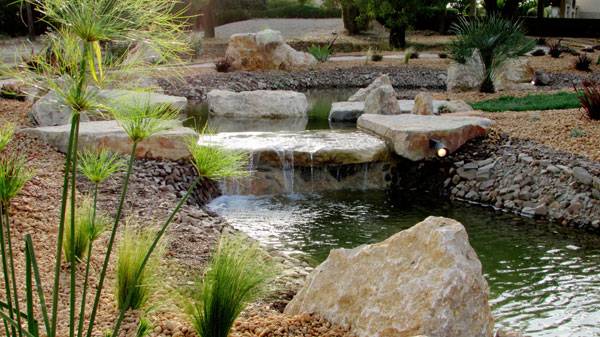
Lake Garden by Iúri Chagas
Designing Sustainable Landscapes
The Lake Garden in southern Portugal illustrates some important sustainable design interventions. Designed by landscape architect Iuri Chagas, the Lake Garden covers 900 square metres in the Algarve, an area that gets more than 3000 hours of sun per year and with an average rainfall of only 500 mm per year.
Meticulous Choice of Native and Drought-Tolerant Species
Designing planting schemes in a dry and hot climate is surely more challenging than working in a mild cool environment where basically everything thrives. In such arid Portuguese locations, the rule to follow pretty strictly is ‘the right plant for the right place’ because otherwise there is little chance that the planting will be successful. Native plants are the most adapted to the climatic and edaphic conditions of an area and therefore should be prioritized, but often there is a need to enrich a scheme with species that are not native but equally tough and which possess special characteristics.
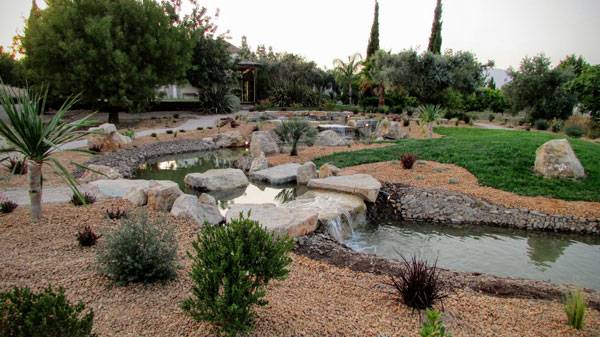
Lake Garden by Iúri Chagas
Using Mediterranean Species
In the Lake Garden the bulk of the plants is native and reflects typical Mediterranean species such as Olea europaea (olive), Prunus dulcis (almond) and very common shrubs, like Arbutus unedo, Myrtus communis, Viburnus tinus, Nerium oleander, Lavandula and Rosmarinus offinalis. Nevertheless, the designer also included, among native species, some exotic grasses and perennials to add drama and give the garden a more ornamental and dynamic look. He included, in particular, ornamental grasses to add movement to the planting, such as Pennisteum ‘Rubrum’, Stipa tenuissima, Festuca glauca and perennials like Phormium tenax.
Working with Local Materials
Considering that the Algarve region’s topography is hilly and the geology rocky, I would expect a lot of local rocks in the garden. The Algarve coast is famous for its picturesque limestone cliffs, a material widely used in the Lake Garden.
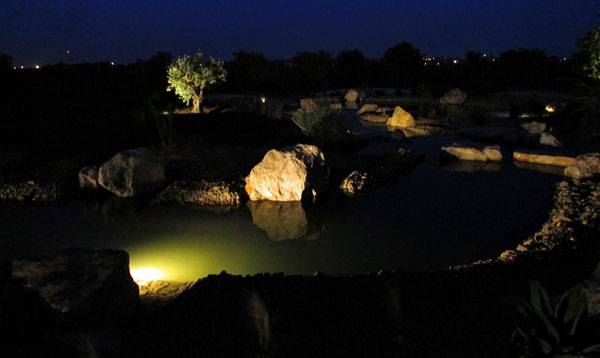
Lake Garden by Iúri Chagas
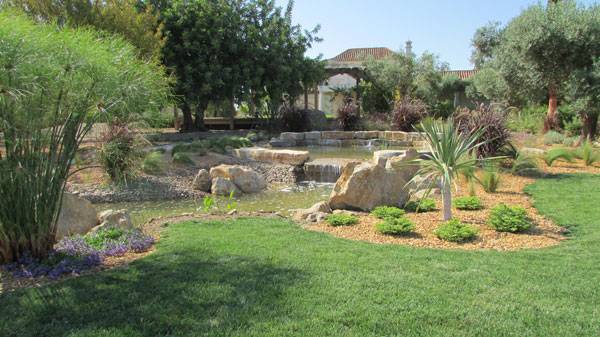
Lake Garden by Iúri Chagas
Using Water as a Means of Habitat Creation
This garden has several ponds that follow the sloping topography of the site and are connected by a stream which meanders through the garden and encloses areas of lawn and planting. Using water in a landscape that is actually dry seems at first glance a controversial decision, but if you consider the amount of habitat that a simple pond could create for the local fauna, then the decision to use water seems an environmentally sound one. Water bodies in this garden not only convey a ‘refreshing’ illusion to its users, especially in this hot location, but more importantly, they attract many wildlife species. All ponds’ banks in this garden are gently sloped with rocks and vegetation, creating the ideal conditions for insects, spiders, amphibians, reptiles and small mammals to easily access the water. The banks were covered with pebbles from the Algarve rivers, which helps to create riverside conditions similar to those found in the area.
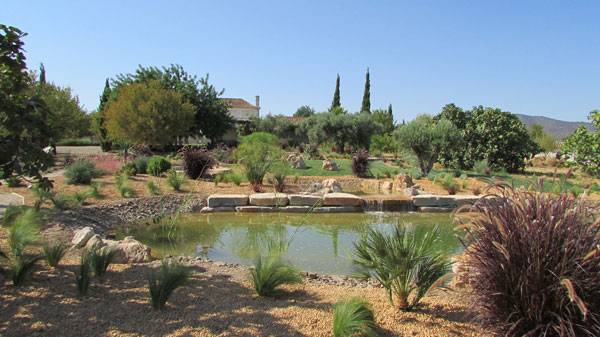
Lake Garden by Iúri Chagas
Horticultural Practices
Since water is very limited in the area, every horticultural practice is aimed to save it and to keep the soil moist as long as possible. The designer decided to mulch all flower beds with gravel from the region. The gravel layer keeps the soil moist and inhibits weeds growth.
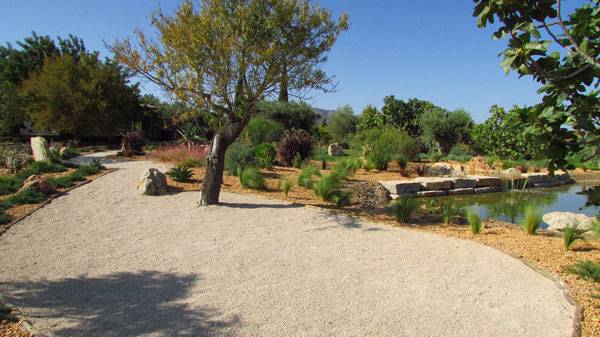
Lake Garden by Iúri Chagas
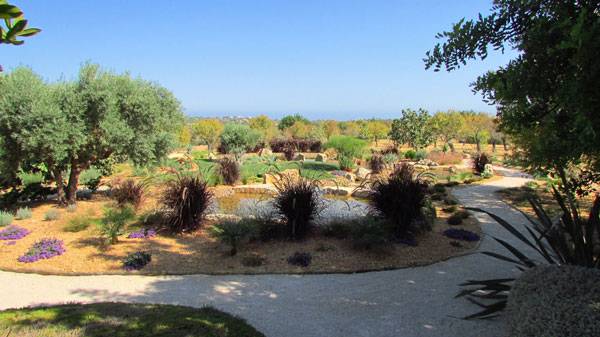
Lake Garden by Iúri Chagas
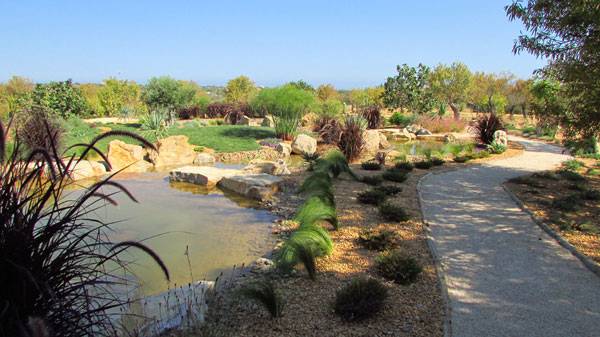
Lake Garden by Iúri Chagas
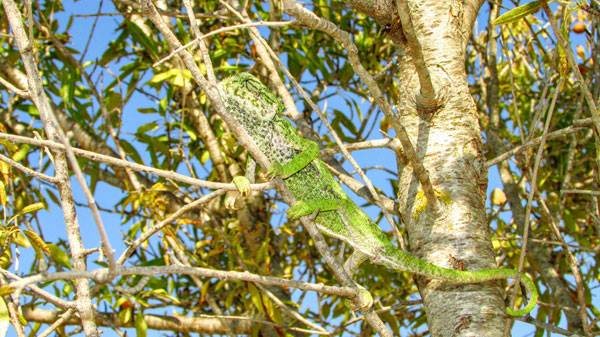
Lake Garden by Iúri Chagas
Full Project Credits For Lake Garden :
Project: Lake Garden Designer: Iúri Chagas Location: Olhão, Algarve (Portugal) Size: 900sq/m Completion Date: 2015 Client: Private Landscape Contractors: Jardimgarve Recommended Reading:
- Becoming an Urban Planner: A Guide to Careers in Planning and Urban Design by Michael Bayer
- Sustainable Urbanism: Urban Design With Nature by Douglas Farrs
Article by Giacomo Guzzon





